Renewable Energy and Its Importance.
For the last few years, the world has been facing unprecedented impacts of global climate change. The global temperature rise is recorded more than 2-degree annually, this has a serious consequence on our natural ecosystem. Natural disasters like flooding, typhoon, melting glaciers, and mega-fires are becoming more and more frequent. Amongst many factors causing an increase in global temperature, one of the main factors is the use of fossil fuel-based energy for our energy needs. The fossil fuel-based power generation units have been generating a catastrophic quantity of carbon emission and other greenhouse gases. There is a desperate need to control carbon emissions to save our planet from the natural catastrophe caused by the rise in global temperature.
To reduce carbon emission, one of the main sources to generate energy is focused on renewable energy. Renewable energy is a source of clean, everlasting, and progressively competitive energy. They differ from fossil fuels principally in their diversity, abundance, and potential for use anywhere on the planet. Renewable energy reduces carbon emission, consequently controlling climate change.
Renewable energy potential of US Northeast
Northeastern states have immense renewables energy potential. The below figure reveals wind energy potential in US states. Northeastern states has abundant wind and solar energy potential, especially offshore wind energy potential. Each states has set ambitious target to reduce their carbon footprints and carbon emission. Following is the highlights of northeast renewable energy ambitions.

Benefits of RECs (Renewable Energy Credit/Certificate).
i. What is REC? A REC, also known as a green tag or renewable energy certificate, represents the property rights to the environmental, social, and other non-power qualities of renewable electricity generation. A REC, and its associated attributes and benefits, can be sold separately (unbundled) from the underlying physical electricity associated with a renewable-based generation source or together (bundled). When unbundled, it is also known as a tradable renewable energy certificate (TREC). A solar renewable energy credit (SREC) is a REC specifically generated by solar energy. Purchasing RECs is equivalent to purchasing renewable energy; if your company buys RECs then you can claim that the energy you use comes from renewable sources. A green energy provider (such as a wind farm) is credited with one REC for every 1,000 kWh or 1 MWh of electricity it produces. A certifying agency gives each REC a unique identification number to make sure it does not get double-counted. The green energy is then fed into the electrical grid, and the accompanying REC can then be sold on the open market.
Followings are the key benefits of RECs.
ii. Directly Investing in Renewable Power. Having solar panels on your home is an excellent idea for a green future and investment, this sort of renewable energy system isn’t a financially feasible option for some people due to expensive renewable products. RECs are an easy way for people who want to make a difference to have a positive impact on the world. The RECs help you:
iii. Achieving Clean Energy Goals. RECs are a flexible tool to help achieve clean energy goals and support the renewable energy market. They can be attractive to companies in regions where green pricing programs are not offered or are insufficient or where policy support for on-site projects is lacking. By purchasing RECs, businesses do not need to alter existing power contracts to obtain green power. Additionally, RECs are not limited by geographic boundaries or transmission constraints. For corporations with facilities in multiple states or energy grids, a consolidated REC procurement can be part of a strategy to meet overall clean energy goals.
iv. Enables utility companies to meet renewable targets. In northeastern states with a Renewable Portfolio Standard, a RECs purchase enables the utility company to meet its minimum renewable electricity percentage without having to install that renewable generating capacity itself, regardless of the source of generating renewable energy. By analogy, in the EPA cap and trade program, a "clean" utility in one state can sell its NOx credits to a "dirty" utility in another state that would otherwise have to install additional smokestack scrubbers.
v. Beneficial for Business. Businesses are increasingly trying to become more socially responsible by taking action against climate change. RECs in northeast states provide a simple and effective way to support renewable energy generation without having to invest in large energy generation projects, like wind farms or solar panels. Major companies have all pledged to obtain 100 percent of their electricity from renewable resources. These companies are sensing a shift in public concern over pollution and carbon emissions. Using renewable energy contributes to a positive brand image and builds relationships with the community, employees, and other stakeholders.
Article Reference
Draxl, C., B.M. Hodge, A. Clifton, and J. McCaa. 2015. Overview and Meteorological Validation of the Wind Integration National Dataset ToolkitPDF (Technical Report, NREL/TP-5000-61740). Golden, CO: National Renewable Energy Laboratory.
Draxl, C., B.M. Hodge, A. Clifton, and J. McCaa. 2015. "The Wind Integration National Dataset (WIND) Toolkit." Applied Energy 151: 355366.
Lieberman-Cribbin, W., C. Draxl, and A. Clifton. 2014. Guide to Using the WIND Toolkit Validation CodePDF (Technical Report, NREL/TP-5000-62595). Golden, CO: National Renewable Energy Laboratory.
King, J., A. Clifton, and B.M. Hodge. 2014. Validation of Power Output for the WIND Toolkit PDF(Technical Report, NREL/TP-5D00-61714). Golden, CO: National Renewable Energy Laboratory.
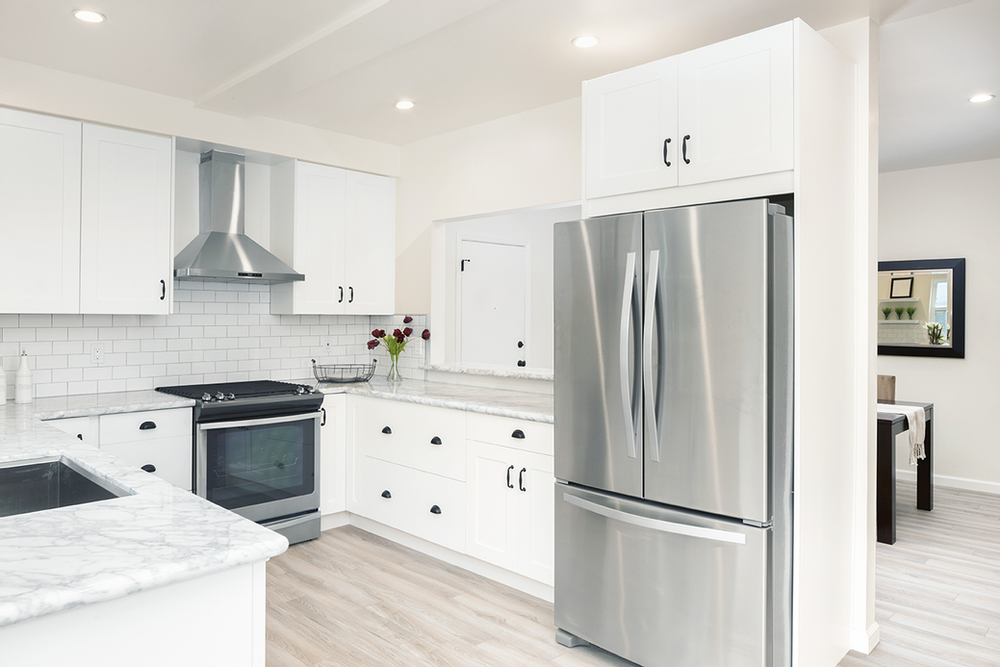
As more awareness is brought to the need to increase energy efficiency and reduce wasted energy, not to mention the financial benefits that households receive by minimizing their utility bills, many people find themselves wondering what the best way to start is. You can take the basic actions that many people already know about, such as replacing incandescent lightbulbs or buying ENERGY STAR appliances, but is that enough? Many homeowners are left unsure what other options are being left on the table.
Luckily, this rising awareness and concern for saving energy, both for the sake of carbon footprints and household budgets, brings with it a growing industry of companies, professionals, and services who are ready and able to help you find the optimal and most cost effective energy solutions for your homes. Energy audits and home energy assessments are becoming commonplace, and if you’ve never had one performed on your home then keep reading to see how they can help you.
Energy audits and home energy assessments are two terms for the same practice. As defined by the American Council for an Energy-Efficient Economy, energy audits are “thorough accounting of the energy use of a building.” Put in plain language, energy audits simply mean taking stock of what uses energy in your home and how much energy each part of the home uses, then using that information to identify where energy could be used more efficiently or building upgrades can be implemented to minimize the amount of energy needed in the home to accomplish the same end functions.
The basic idea behind a home energy audit is that many homeowners look at their energy use and the ultimate power bill delivered to them each month as a sort of black box. You use the electricity or gas in your home as you need and in the end a power bill is delivered that’s usually about the same amount, but that’s just the family’s ‘assumed cost’ of energy. Sure, they may notice that months that are particularly hot see the utility bill rise because the air conditioner is working overtime, but that change is typically the extent of the variability assumed. Home energy audits pull back the curtain and reveal where, in fact, energy is being wasted when it doesn’t need to be and how that monthly utility bill can be brought down in cost-effective ways.
The U.S. Department of Energy notes that home energy audits should be any homeowner’s first step before trying to make energy upgrades to their house, noting that such assessments can come via Do-It-Yourself Home Energy Audits or Professional Home Energy Audits.
For the DIYers out there, homeowners can run through a checklist of items to look for from DOE, which includes:
Locating air leaks
Assessing ventilation
Checking insulation
Inspecting your HVAC system
Replacing inefficient lighting
Upgrade appliances and electronics
However, even equipped with this list of areas of the home to check, many homeowners will struggle to identify exactly what constitutes good or bad energy efficiency practices. For that reason, having a professional home energy audit completed is typically advised. Experts who perform home energy audits are trained to inspect each of the above items and more. They will certainly be able to detect areas of concern that you may miss with you untrained eye, and even more valuably they are also already knowledgeable in what type of solutions will be best suited for your home, your price range, and your specific needs.
Professional home energy auditors can be found in a number of ways. Many companies exist where performing these home assessments is what they do, and you can find some great options by checking out the listings for your area online or in the phone book, or even by talking to your neighbors to see if they’ve had assessments done. If you do talk to neighbors who have had energy audits, you may find that they’ve gotten theirs through the local utility or via the state or local government, all entities that commonly offer programs for home energy assessments. So, be sure to check with these organizations in your area to see if there such solutions are possible for you.
Just because a home is a new one does not mean that there aren’t opportunities for energy savings, as construction practices don’t always take energy efficiency as seriously as you may, and energy efficiency technologies evolve greatly from year to year.
Specifically, some of the most common findings from an energy audit that you’ll want to embrace via home upgrades include (but are not limited to) the following:
Replace inefficient lighting, appliances, water heaters, or HVAC equipment
Engage in maintenance measures in the heating and cooling systems, such as replacing air filters more regularlyInstalling high-efficiency windows or doors to prevent heat lossHiring someone to air seal your home and prevent leakage of heat and airUpgrade to a programmable or even smart thermostat.
The Alliance to Save Energy provides the following example table on how much these upgrades may cost you but also how much an average home may save in annual energy costs and assess the period of time before those cost are recouped:
This table is just an example, but it shows how a professional home energy audit can uncover the energy upgrades that are the most cost-effective (those with payback periods of less than 10 years) and which are not as low-hanging fruit for the family (those with longer payback periods).
In the end, you tend to trust other professionals to tell you where things are falling short, whether that’s a doctor to assess your health, a mechanic to evaluate your car, or an accountant to look at your taxes. So why not utilize a professional home energy audit to check out your home’s energy use—the initiative will almost surely pay for itself in the end.
Switching energy suppliers is not available to everyone across the country, as those who still live under the monopoly of a regulated market are restricted to just the one company to provide them power. However, for those who live in a market that is deregulated, and thus allows consumer choice of energy supplier, a question will immediately come up is: why should they change?
It’s a valid and important question and one that should not be taken lightly. As with any other major purchasing decision, choosing whether you should switch to a new energy supplier is a personal decision and one that has many different factors involved. That said, when you do your homework and find out if you’re able to switch suppliers and who your options are, you may find a number of customer benefits of doing so that will make your decision even easier!
Potentially Cheaper Rates
For many energy suppliers, the decision to switch or not will come down to one thing: what are the rates? Will you be paying less? If you do research into the options of companies who can supply you with your power, you very well may find that the rates being charged by the alternatives are lower than the rates you are currently paying to your incumbent utility. The ability to pay less cannot be overstated as a benefit, and it’s definitely among the most popular reason that customers may opt to switch energy suppliers.
Rate Structures That Align With Your Goals
Rates that you pay to your utility company and/or to a new energy supplier aren’t always as simple as a single cost per kilowatthour (kWh) of electricity though. Different energy suppliers will offer different rate structures, and examining those structures may uncover a new type that actually works better for how you use energy or budget for your monthly bills.
For example, different suppliers can offer fixed rates vs. variable rates. Fixed rates lock you into a single cost per kWh no matter how much you use or anything else, so you’ll have a very clear and predictable idea of what your bill will be at the end of the month. Others, though, will offer variable rates that will go up or down based on how much energy costs on the open market. These types of rates mean that you could potentially pay less than if you had a fixed rate, though you also could end up paying more. So variable rates are only appropriate for people who are willing to stomach that risk and who aren’t on a very fixed and tight budget.
Further, some additional rate structures will offer one price for the first certain amount of energy, then change rates based on if you exceed that amount; others will offer rates that vary based on what time of day you’re consuming the energy supplier, and there are others. The point is, though, that each of these different rate structures may appeal to a different segment of the population, so if you look into your options you may find a new rate structure you like better than your existing one.
Decreased Carbon Footprint
Outside of changes in how much you pay each month, a common reason to change energy suppliers is because of a desire to reduce your personal carbon footprint. With the incumbent utility you’re locked into the type of energy mix they use, whether that’s coal or gas or any other carbon-intensive fuel, but when you choose an energy supplier you can choose one that has a greater concentration of renewable energy generation (some even offering 100% renewables). While the exact way this renewable energy gets assigned to you is a bit complicated, many customers opt for a new energy supplier out of a desire for their power bills to be supporting suppliers who invest in and utilize eco-conscious and green energy sources. So if sustainability of your energy is a top concern, you may want to see what renewable energy offerings other energy suppliers have out there.
Energy Supplier Who Listens to Your Concerns
Broadly speaking, the ability to choose your energy supplier allows you the option to cut ties with a power company that doesn’t listen to you and find one that does. This really can be the X-factor, and whether you’re seeking an energy supplier with better customer service, with customizable programs to suit you, with rewards for loyal customers, or anything else. The beauty of an open and competitive market is that your vendor must now prioritize you as a customer or you can switch to an alternate who will. And that power of being a customer is invaluable.
Since the early days of Edison and the dawn of the utility sector, power providers have typically enjoyed a regulated monopoly over their customers, meaning end-users did not have any choice when it came to energy companies. There would be a single utility company that controlled the power lines going into homes and businesses and so customers would have no ability to take their business elsewhere.
In recent decades, though, more and more areas of the U.S. energy sector have been deregulated through government action, meaning that customers newly would have the agency to choose who would produce power and bill them for it. This trend is a drastic change in areas where it’s implemented, but because most people are so used to the status quo of regulated monopolies there is a lot of confusion and misinformation about what deregulation actually means for customers. So if you’re in a state that’s currently deregulated or there’s a groundswell of grassroots support for energy choice in your state, take note of the following need-to-know information about how deregulated energy works.
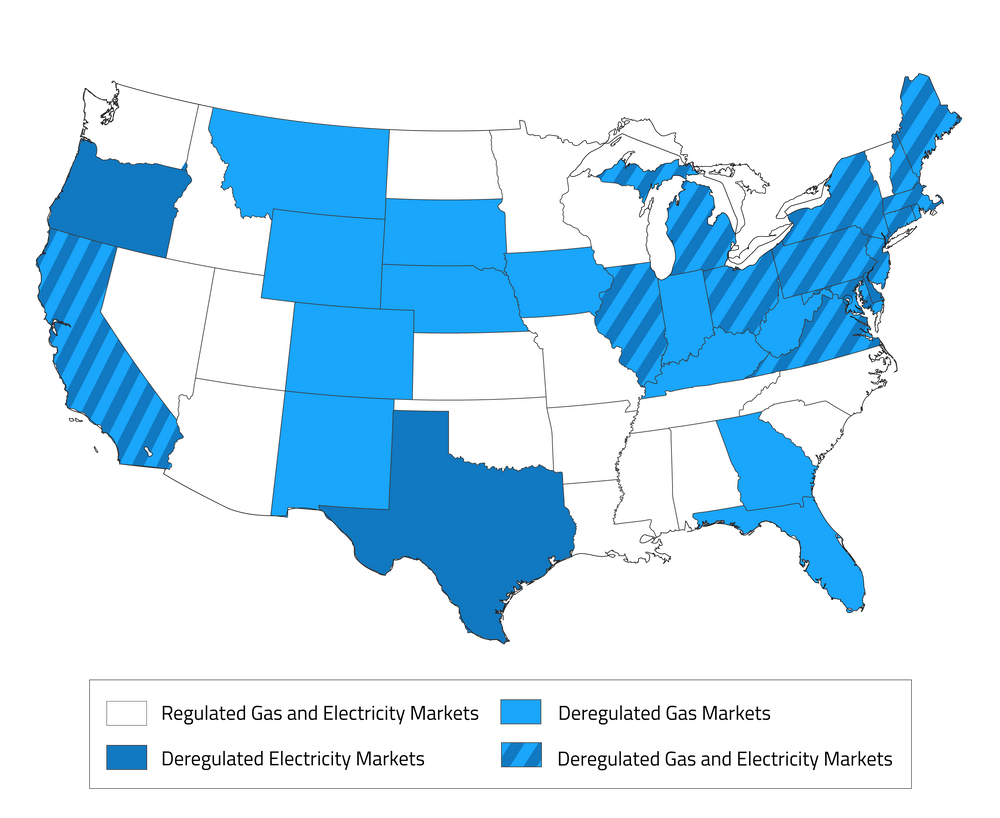
Where is energy deregulated and who can exercise energy choice?
Currently, states where energy is deregulated are in the minority. And for those states that do allow a level of energy choice, there are different levels of deregulation: some do just electricity or just gas; some allow residential customers or just commercial/industrial customers, and some restrict energy choice based on total energy use for the customer or other factors.
The states where state governments have enacted laws to allow for some level of energy choice in a deregulated electricity market for households are the following: Connecticut, Delaware, Illinois, Maine, Maryland, Massachusetts, Michigan, New Hampshire, New Jersey, New York, Ohio, Pennsylvania, Rhode Island, Texas, Virginia, and Washington D.C.
However, because of the other restrictions that are sometimes instituted, it’s important for individual customers to do their research on where and if they may be eligible to take advantage of energy deregulation. For example, residents of New York, New Jersey, Pennsylvania, Ohio, Illinois, Maryland, Connecticut, Massachusetts, and Washington D.C. are likely eligible to choose Atlantic Energy as their energy provider, but calling Atlantic and asking for more details can answer any questions you may have about your ability to take advantage.
How does deregulation affect power prices?
For most customers, satisfaction or dissatisfaction with their power provider comes down to one simple thing: what is their final monthly bill? As such, looking at how deregulation ends up affecting power prices is a crucial question.
A recent study by researchers at Ohio State University identified a lack of energy competition as being responsible for energy cost increases across Ohio. And while energy prices have been generally rising across the country, a detailed analysis of those rates separated into deregulated and regulated markets found that deregulated states only saw prices increasing by 47% over the past two decades compared with a 66% increase in regulated states.
So for customers looking at whether or not deregulated markets would be something they’d want, they need to look no further than these data points to realize the lack of competition in their local energy markets could be hitting their monthly budget more than they realize.
How does a different energy company get power to my home? Is new equipment required?
One of the reasons that regulated monopolies started in the beginning and have persisted since then is because of the high capital cost it takes to build out the infrastructure needed to transmit and distribute electricity from point of generation all the way into the final use in the home. It made more economic sense to only do that once by one company and that would be the way people got power.
Those economics still work that way, so if you are in a deregulated state and you choose an alternative power provider you’ll actually still get your energy delivered over the same grid and vast wired network. In these situations, you’ll also still end up paying the same legacy utility company for the transmission & distribution costs across their grid system, but the difference will be that you’ll pay a different company the cost of the power generation. It becomes an accounting exercise, as there is no way to ensure that the electricity physically created at the alternative electricity is delivered into your home, but rather you pay your new power provider for the amount of electricity you use and they ensure that amount of power is provided by them to the greater power grid.
In that way, you don’t need any equipment installed on your home and we can continue to use the same existing grid infrastructure, but you still get all the benefits of the power to choose your power provider.
What impact does deregulation have on power providers?
The system of monopolistic utilities is unique in the U.S. economy because it does not allow for competition and the benefits that bring to customers, nor the innovative momentum it brings to utilities. Companies that don’t have concerns that their customers may leave them for competitors who are better or cheaper lose the motivation to innovate. They can get complacent and thus not deliver the optimal service.
In areas with deregulated energy markets, though, competition makes everyone better. If customers are demanding more renewable energy in the mix, a new ‘green’ competitor may come along to attract these eco-conscious energy consumers. If customers are seeking neat perks, such as the smart home bundle that Atlantic Energy provides its customers, then they can ask their existing utility if they have anything like it and leave for the competition if they find something they like better. Deregulation forces the utilities to be more committed to the needs of customers, rather than simply finding ways to maximize their profits.
As a customer, the deregulation of energy markets puts you back in the driver’s seat. You can find the power provider who matches your needs and values best, not feeling beholden to the only game in town.
Smart home products have gone from futuristic ideas or toys of the wealthy to real tools for the average family to manage their home, save energy, and seamlessly improve their lives. Because of the immense benefits they can provide a home, Atlantic Energy has been proud that customers can receive up to $650 of smart home products as customers when they sign up for the Smart Home Bundle. Throughout the first two years of Atlantic Energy providing your home's power needs, you'll be fortunate to accrue:
These various smart home products enable users to control them remotely, using a phone, tablet, or even Amazon Alexa or Google Home. They connect to the home's wireless internet, meaning that users can even turn them off while across the country, can set schedules of when certain products should be activated or not, or even set up programs that allow for the products to react to variables like the humidity outside, the time of sunrise or sunset, weather, and more.
Unlocking all of these great features is the Atlantic Energy app for your smartphone. The Atlantic Energy app can work as the one-stop-shop for all the tools and programs possible, which really opens up the doors for creative ways to enhance your daily life and save energy.
To prove this point, keep reading for a how-to on setting up the app as well as an overview of what's possible while using it!
Downloading and Setting Up the App
Before getting started on all the possibilities of the Atlantic Energy app, the obvious first step is to download it to your smartphone. Go to the app store of your choosing and search "Atlantic Energy" for download.
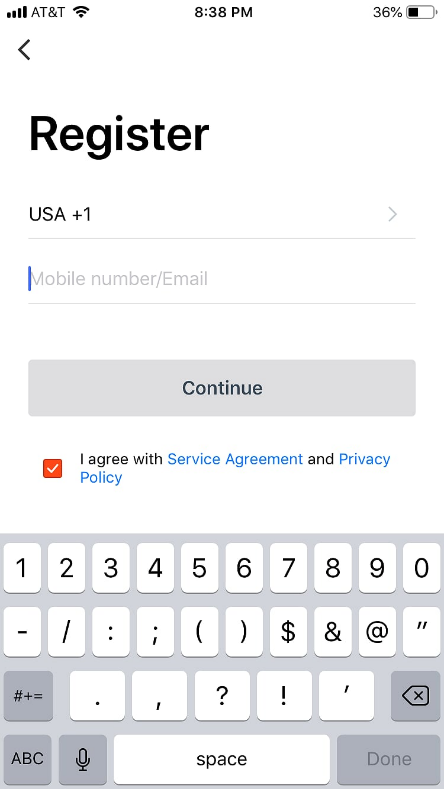
After the download is complete, you'll have to go through the registering and set up process. Create an account on the app...

At that point, the app will still pretty useless for you until you connect the smart home devices you've received to the app. The first package you'll receive as a part of your Smart Home Bundle is 3 Wi-Fi Smart Lights and 1 Wi-Fi Smart Camera. For instructions on how to connect these to your Atlantic Energy app, see this post on smart light setup.
Using the Atlantic Energy App
Now that you've downloaded the app and installed your products, it's time to see what that Atlantic App is really capable of doing.
Home Screen
The home screen of the app will display all the information you need to know right away. In addition to displaying the weather, humidity, and air pressure at your home, you'll see the buttons for preset scenes (more on that later), the listing of devices that are connected (which you can view all at once or room-by-room), and access the other settings you may need (adding more devices, creating new rooms, etc.).

Device-by-Device Functioning
On that home screen, you can select each of your individual devices that's connected to the app to control them manually. For example, selecting one of your smart light bulbs will bring up the screen to control the brightness, color, and on/off function of the light.
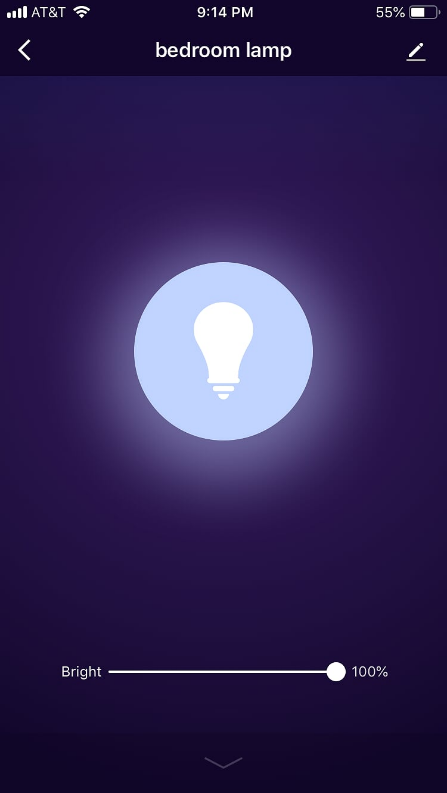
Similarly, you can select any of the cameras connected to your app to view a live feed of the video in that screen and operate any of its functions, like motion detection, two-way speaker, recording, or taking a photo.
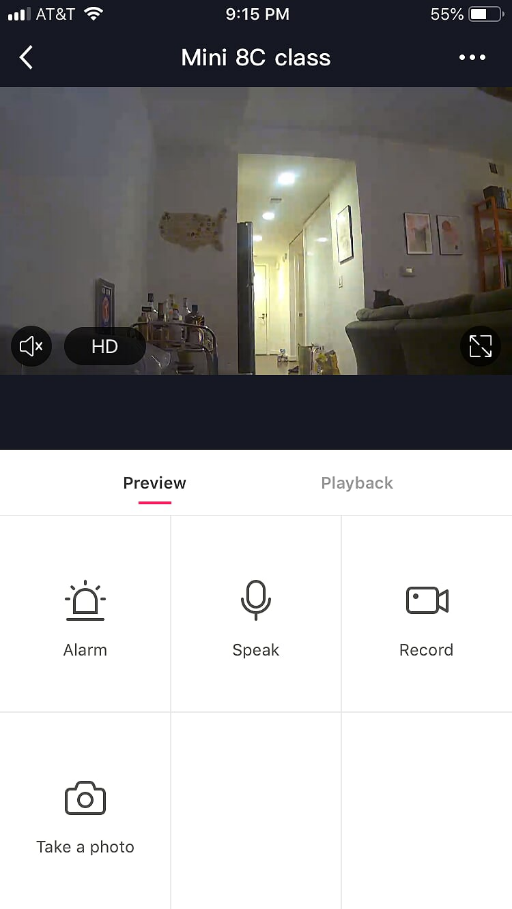
Setting Scenes
To operate your devices in a more system-wide function, you can create 'scenes' for your devices. By selecting the 'smart' button at the bottom of the home screen you'll be taken to a screen displaying all of your scenes previously set up and an option to create new scenes:
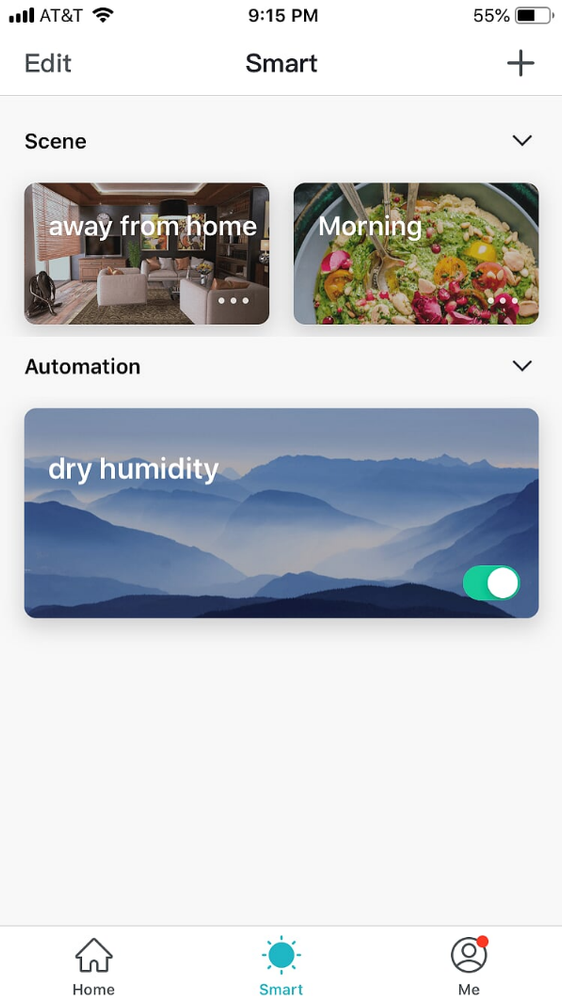
By pressing the + in the upper right corner you'll see the option to add a scene.
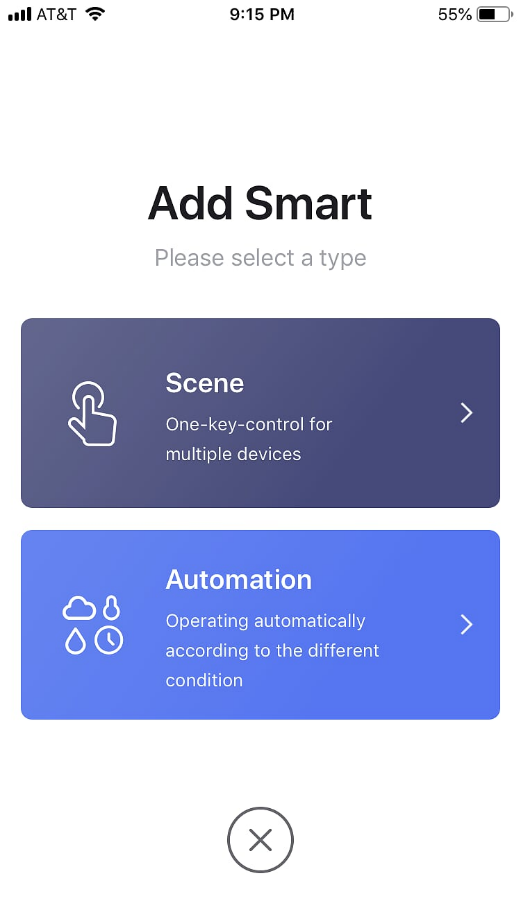
Each new scene will allow you to describe the reaction of each connected device when that scene is set. For example, you can set a morning time scene that will turn on specified lights at low brightness (so your eyes can adjust to the light), while leaving hallway lights still off and turns on the smart plug connected to your coffee maker. Rather than having to activate each of these devices individually, these scenes allow them all to happen with the press of a single button.

As noted earlier, you can have these scenes as buttons on the home screen for easy access, or you can ask Alexa to activate these preset scenes.
Creating Automation
Similar to scenes, automations are found in the 'smart' section of the app and allow you to have automatic actions follow given external triggers.
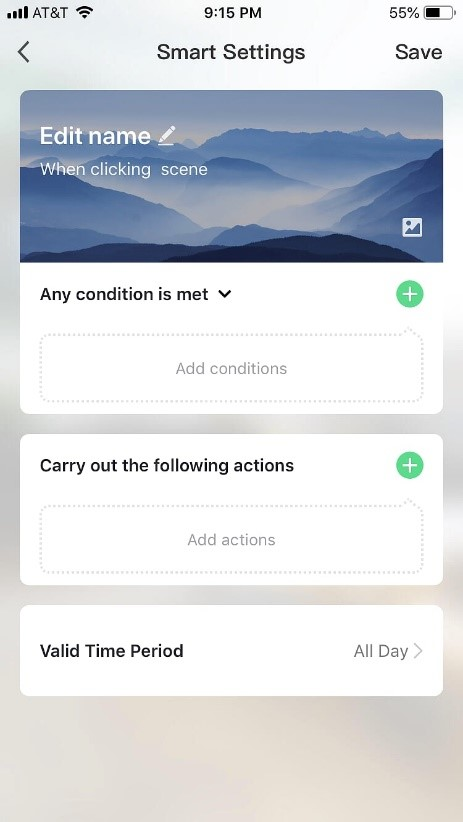
By adding a smart automation, you can set a trigger based on temperature, humidity, weather, sunrise/sunset times, timer, or device/sensor input.
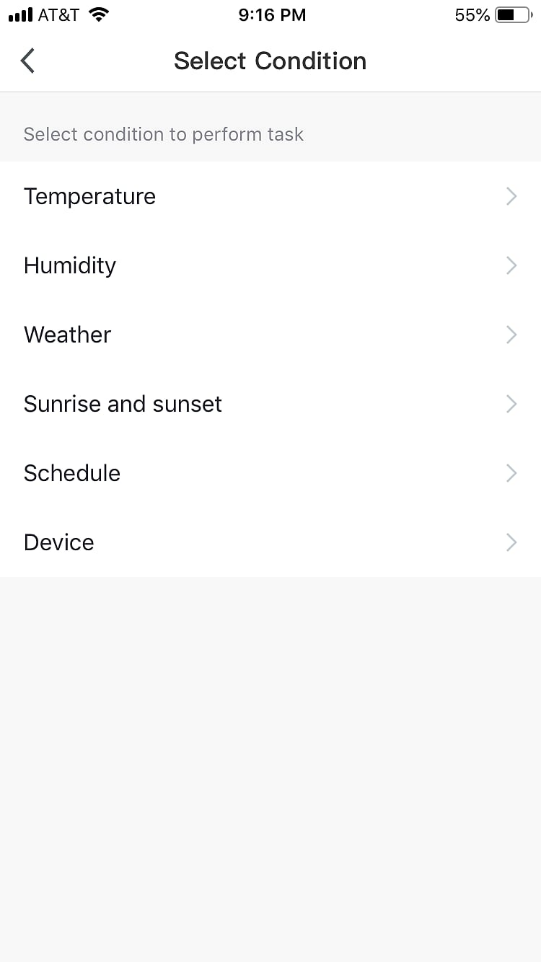
If that trigger happens, then the suite of devices you've connected can react in a given way. For example, you can note that if the humidity drops to a certain level that the plug controlling your humidifier turns on, or you can ensure that the lights be set on to a given brightness in the time between sunrise and sunset if the weather is particularly cloudy. Again, the options are only bound by your creativity and ingenuity.
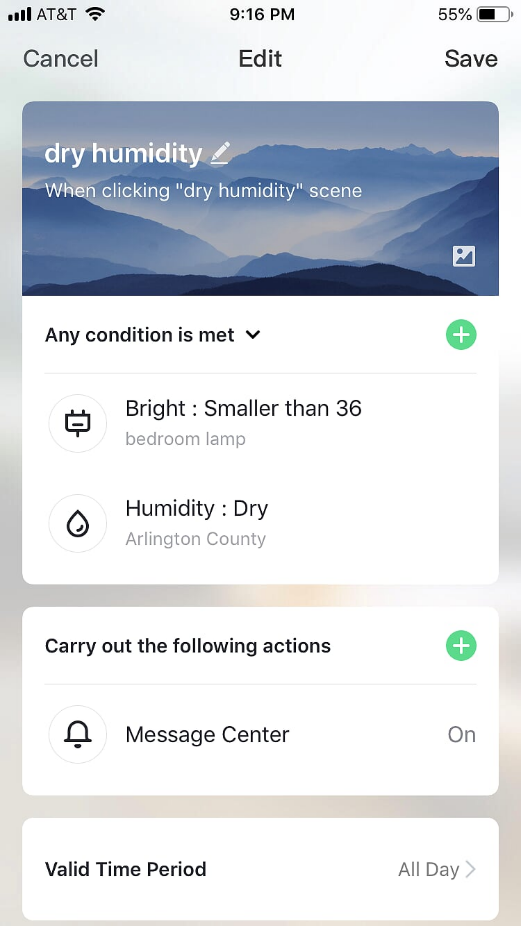
Add Family
This function opens up the products to be operated by more than one person in the household, which is critical if you have a larger family who all would want access to the cameras or adjusting the lights. You can grant access to the devices to a group of member that you name as a 'family,' provided they've also downloaded the app and registered an account. You can even create separate groups who only get control of certain products. For example, you can create a group for the parents who are the only ones with access to the cameras and a second group for the whole family to have access over the living room lights.
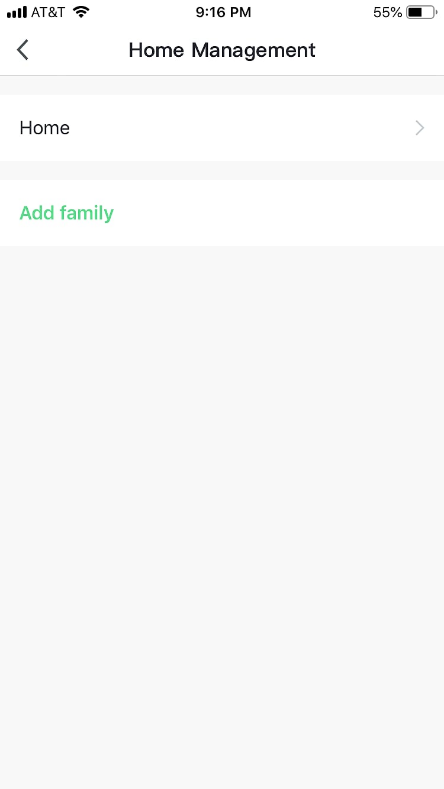
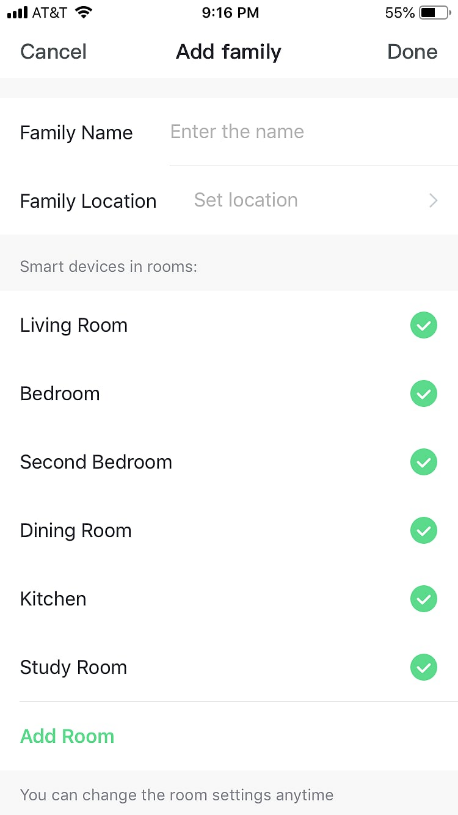
Notifications, Settings, and More
Lastly, if you press on the 'Me' button on the bottom of the home screen, you'll see the hub for the rest of the features and setting you may need. You can update your profile, look at messages/notifications that have been sent to you (such as motion sensing if you've turned that on or weather alerts if you've created automations for that), the help center, and other general settings.
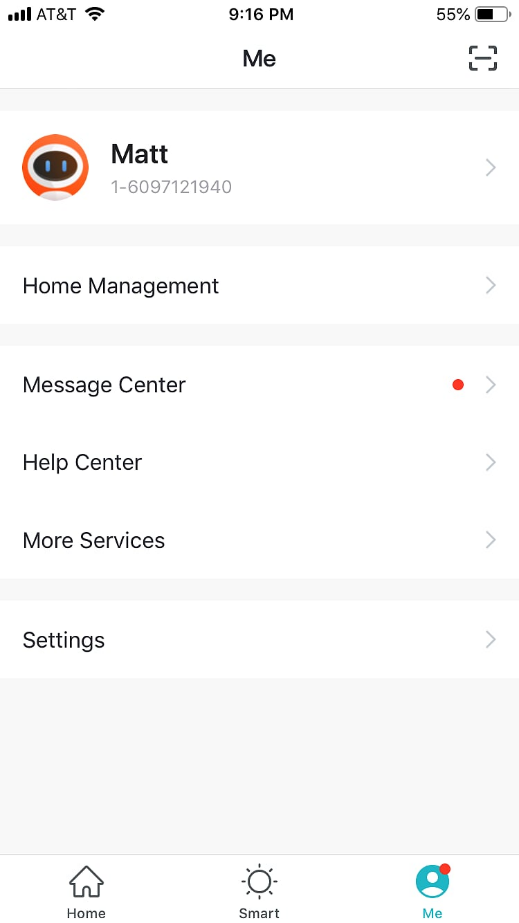
With the above information, you should be more than ready to dive into the Atlantic Energy app and really start to make your smart home devices work for you. Are there additional functions you want to learn about? Or questions you have? Don't hesitate to leave a comment below to ask.
And if haven't yet joined as a customer of Atlantic Energy to take advantage of the amazing Smart Home Bundle, then you can now plainly see the immense benefits and features the Atlantic Energy app and associated smart home products can offer. Contact us today to learn what we can do for you.
Atlantic Energy is proud to offer clean, reliable energy for residential and commercial users at affordable prices. While these numbers speak for themselves, we’re not happy to simply stop there. In an effort to go the extra mile, Atlantic Energy is happy to offer our Smart Home Bundle. Under this program, residential customers are eligible to receive 3 Wi-Fi Color Changing LEDs after 90 days as a customer, along with all the other smart home products during the initial 2 years as a customer that combines for a $650 retail value.
Receiving these free Wi-Fi lights is exciting, but if customers want to ensure they lead to lower energy bills then they need to be installed and used correctly. While it doesn’t take a genius to use smart lights, getting started can still be a confusing process. To assist and make it slightly less confusing, be sure to keep reading to follow along with the unboxing, setup, and use of one of the Wi-Fi Smart Lights from Atlantic Energy for use in an actual apartment.
The Wi-Fi Smart Light delivered by Atlantic Energy is a state-of-the-art light to add to your home. Each light bulb delivers 450 lumens but only requires 6.5 Watts to power. The standard color temperature is 2700 Kelvin, but one of the exciting features is its ability to change to any color of the rainbow (actually, 50 million color combinations!) at the press of a button, not to mention over 15,000 unique shades of white light. Further, the energy-conscious customer will love knowing that they can remotely access these lights to turn on and off, change colors, dim, or schedule no matter where they are in the world without the need for a clunky smart home hub, allowing for control of a single light or multiple lights at once and even open to voice control form Amazon Alexa or Google Home.
To start, the 3 lights you’ll receive will be in boxes like these:


Open it up, and you’ll find a tightly packed light bulb and a brief instruction booklet:

The setup process is easy enough that even those who are typically intimidated by connected technologies should have no issue, especially since everything you need to know can fit into this tiny booklet:
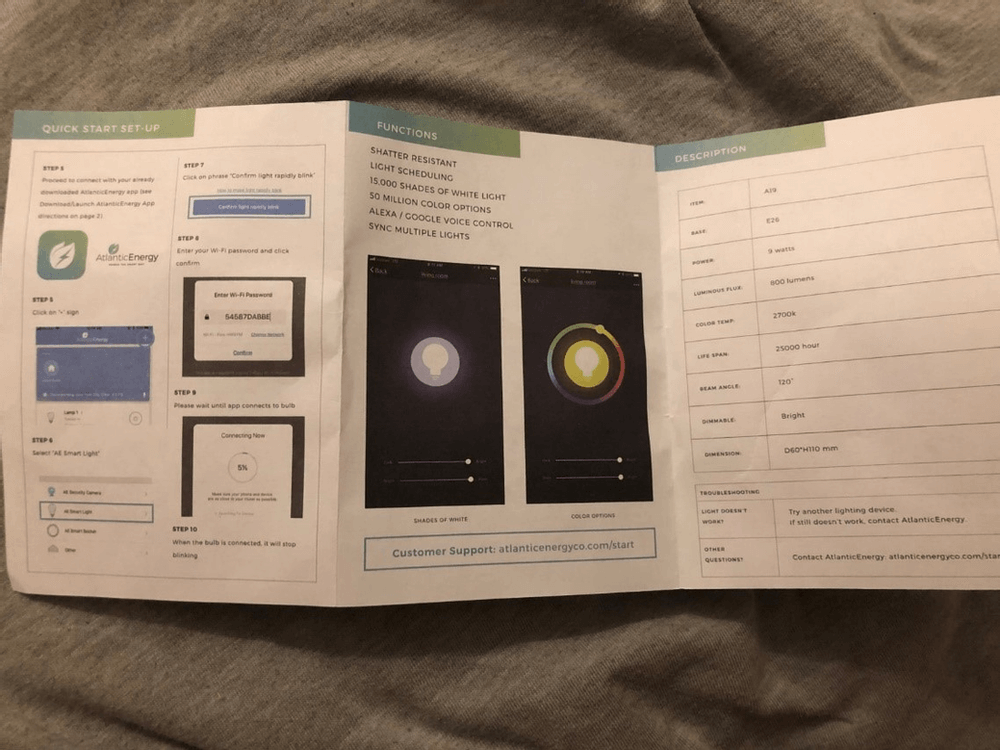
Before grabbing your phone for the ‘smart’ functionality, you’ll plug the bulb into any normal screw-in light socket as you would with any other light bulb (make sure the light socket is turned off, first!):

After plugging in, you’ll turn the bulb off (via light switch, lamp switch, etc.) on and off 3 times, leaving it on the last time. At this point, the bulb will start rapidly flashing on and off. This function indicates that the light is ready to pair with your phone!
Now that the light is screwed in and flashing to indicate it’s ready, it’s time to get ‘smart’ with it. Step one is to navigate to the app store for your given phone and download the Atlantic Energy app:

After the download is complete, open the app up and follow to on-screen instructions to register:

At that point, you’ll see the following empty screen. To add your Wi-Fi Smart Light to the app, start by pressing the + in the upper right corner:

From there, you’ll note that you want to add a ‘Smart Light.’ You’ll then be asked to confirm that the bulb is still rapidly flashing. After confirming that this is the case (and if not, select ‘otherwise’ on the app and it will indicate what you should do to reset the camera to get the indicator light flashing again), you’ll be prompted to enter your Wi-Fi password. You’ll now have to wait for a minute or two for the process of pairing your camera to your phone complete. Don’t hit cancel or navigate away during this time:

Once this is done, you’ll be ready to go! The light will turn on and you’ll be passed on to the control screen for your bulb:

If you’ve gotten to this step, congratulations—just the fun part is left! At the previously shown screen, you can press the center button to turn the bulb on or off, or you can adjust the overall brightness with the slider underneath it:

You can also use the middle bulb button to open up the color features, which brings up all your color palette options. Slide to blue on the app, see your light do the same in real-time!


Slide to green, and watch the change for yourself:
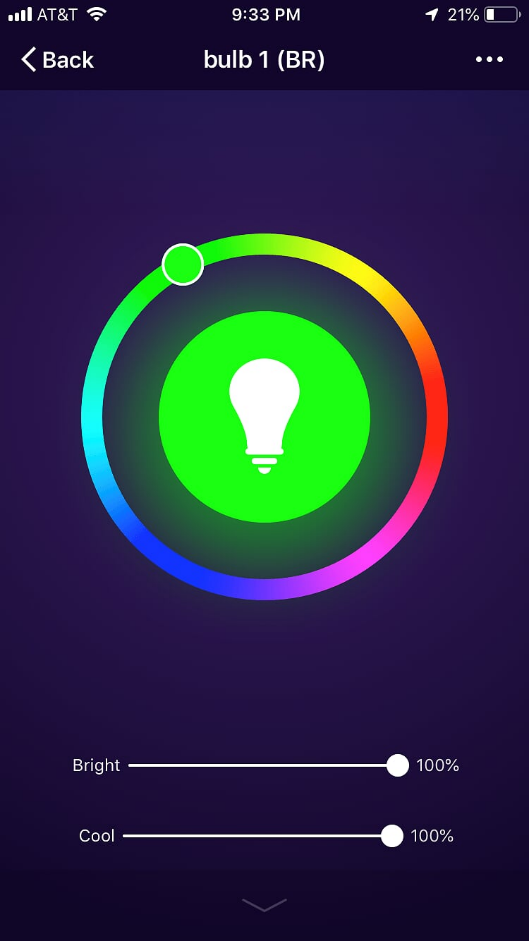
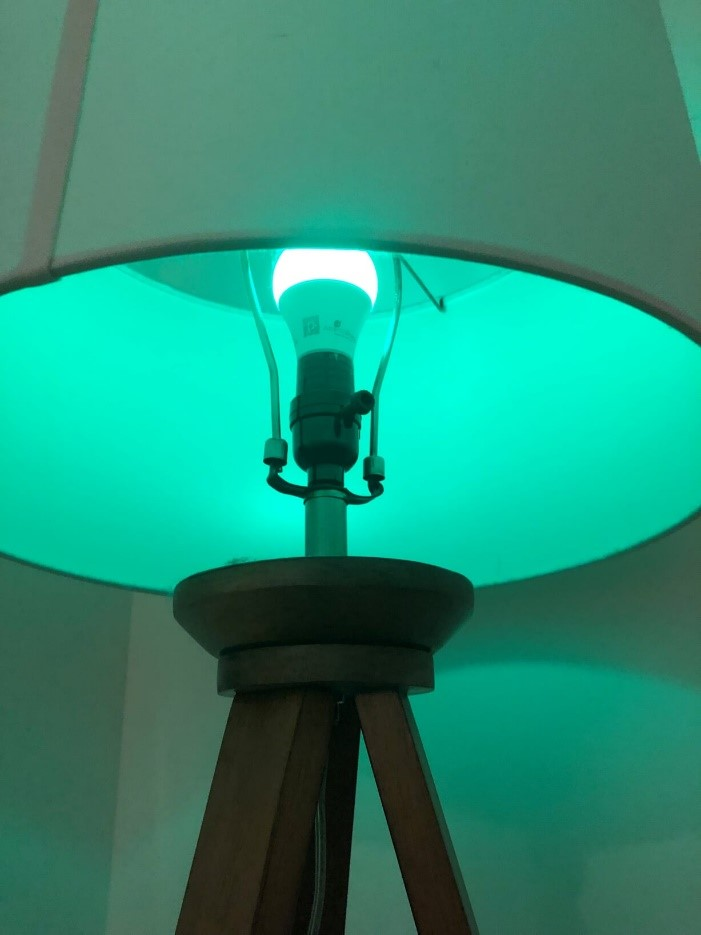
To get even more advanced, press on the … in the upper right corner to open up settings. You’ll see the ability to set a timer/schedule for your lights—to ensure they’re turned off after you fall asleep, are turned on to wake you up with the sunrise, or anything else you can think of:
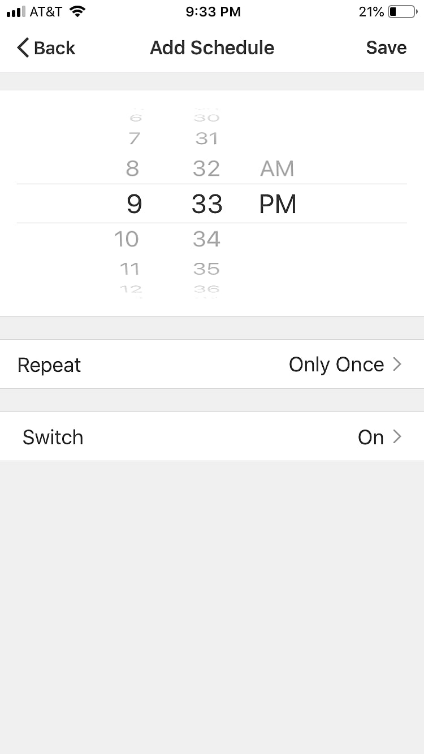
You can also create preset ‘scenes’ for all of your lights, for example a reading scene that’s bright crisp white light across all your bulbs, a rainbow setting that enables different colors for each bulb, or a night-time setting that dims all the lights to lower light levels (saving you on energy and reducing strain on your eyes before bedtime):
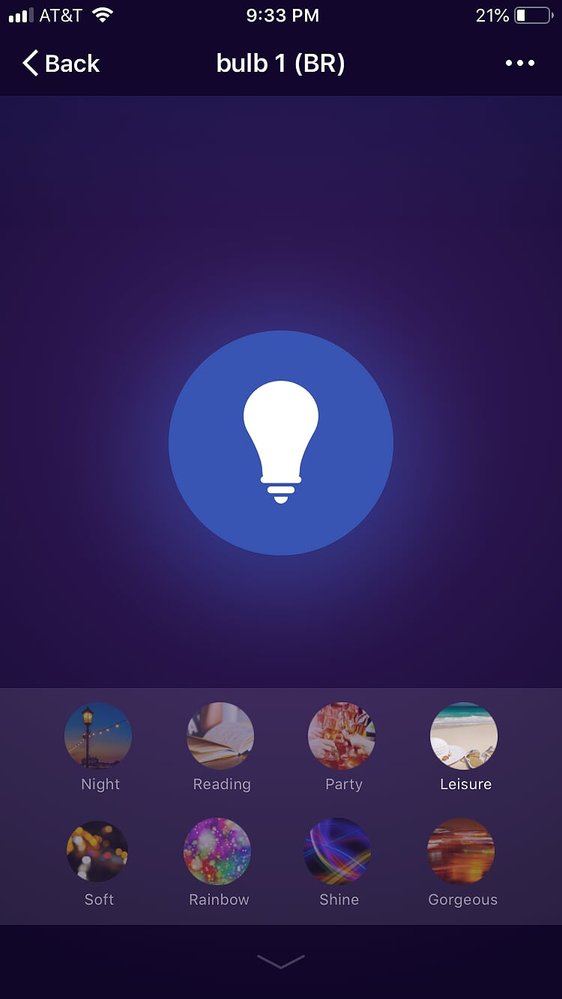
From here, it’s just up to your imagination. Change color settings for your next party, harness dimmed lights to save energy, or make sure your lights are turned off even if you forgot to do it manually before leaving home for a trip. If you’re simply reading this but haven’t yet signed up for the Smart Home Bundle from Atlantic Energy, what are you waiting for? Reach out to us today to see how we can start saving you money on your power bill, ensure your electricity is fueled with cleaner energy, and empower you to embrace smart home technology.
A common refrain when people look at and hear about smart technology is that they wish they could make their home smart, but because they’re not yet homeowners that such a transition is not for them. The idea here goes that because some of the most popular smart home technologies—such as smart thermostats or smart doorbells—require installation directly into the home, sometimes requiring an electrician or at least approval from the building owner, that those who are renting their apartment or home cannot embrace the rapidly growing smart home trend.
However, this line of thinking is mistaken and is further evidence that the general public has lots to learn about the smart home and smart product market generally. The Internet of Things and the general increase of smart products in homes is a valuable tool, particularly for those individuals who want to find new and exciting ways to save energy and, thus, money.
So for those who find themselves renting their home, read on for some of the key ways in which you, too, can embrace the energy benefits of smart home products.

Smart Plugs
An often-overlooked area where smart products are making energy savings possible, for both renters and owners, are in smart plugs. These products plug into existing outlets and then allow you to plug your devices into them, whether that’s a lamp, the various pieces of an entertainment system, office equipment, or anything else. These smart plugs can then be controlled via app, web portal, or even light or occupancy sensors to control when the products plugged into them turn on or off.
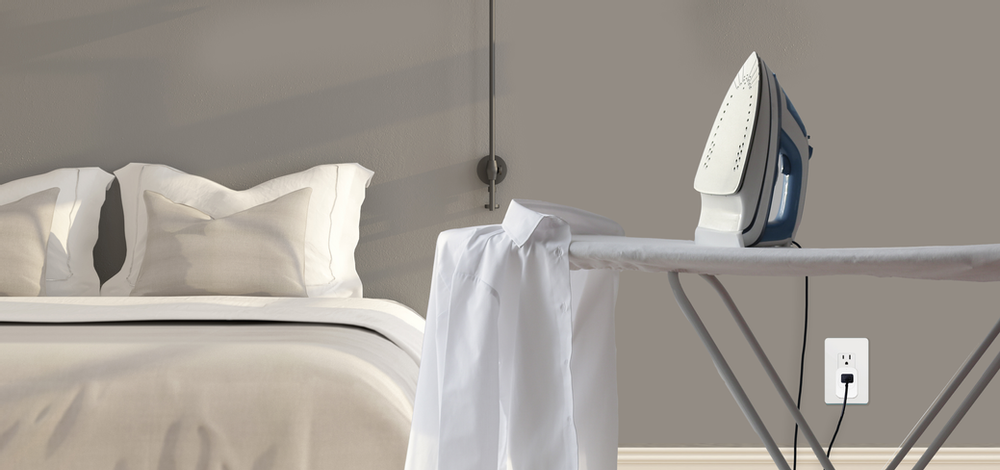
These simple and affordable tools allow you to make sure energy vampires don’t suck unnecessary energy into your devices when you’re not using them, such as leaving your DVD player on and ready to receive instructions from the remotes for weeks in between you popping in a movie. Devices can be left on for any number of reasons: forgetting to turn them off, laziness and not wanting to turn off or unplug all devices, or even just a lack of understanding that energy is still being used when plugged in. But smart plugs can beat all of those problems, allowing you to automatically or on a set schedule turn off these devices when they’re not being used, saving you huge amounts of energy (and money!) in the end.
Smart Lights
Smart lights are one of the most visible and popular parts of the smart home ecosystem, having been around for a long enough time already for people to readily understand and embrace them. Luckily, smart lights aren’t just convenient for turning off the lights from the comfort of under the sheets or for the cool party tricks you can play with the changing colors, but they are a key factor in saving energy in a smart home.
By allowing the automated turning off or dimming of lights to match when and where light is actually needed, thus minimize energy wastefully being used when light is not needed, smart lights are an easy and basic way to get started with saving money in your smart apartment. Even better, you don’t need to worry about getting permission from your landlord because installation is as easy as twisting them into existing sockets. Further, you need not worry about wasted investment when you leave for a new rented home because you can then just as easily unscrew them to take them with you, replacing them with the original light bulbs that were installed when you moved into your rented abode.
Smart Assistants
A key part of the smart home is the ability to bring it all together and make sure convenient arrangements ensure you are likely to use them in the most energy-saving ways possible. Luckily for energy efficiency enthusiasts and smart home nuts, smart assistants or voice assistants are by far the most common smart home technology on the market today. These products, like Amazon Alexa and Google Home, are able to control the various smart home products in your home through simple voice commands . By making the energy-savings functions of other smart products, such as the smart lights and smart plugs in your rented home, more accessible, smart assistants ensure you get the maximum energy benefits out of your investments.
Smart Home Bundle from Power Provider
You can’t make the most out of smart home products in a rented home if you don’t invest in smart home products in the first place. Because such devices can be expensive, many people are hesitant to jump in and embrace the world of smart tech, especially unsure of the energy-saving potential they’d actually get while also being afraid of embracing a technology that’s, in their mind, not as viable in a rented home.
However, many energy providers are starting to embrace the smart home revolution and recognize the value they can bring to customers and the grid alike. Not only do customers benefit when they embrace energy-efficient solutions, but the whole energy system becomes more reliable and affordable because less generation, transmission, and distribution capital will need to be invested in the long run.
Recognizing this ability for smart home products to change home energy management, even in rented houses, your power provider might offer advice and rebates for smart home products, or even provide smart home products. Atlantic Energy offers a range of smart home products, and as previously noted, these products can all be utilized in your home regardless of whether you rent or own. By understanding how to use them (even connecting them to Amazon Alexa), you'll be able to not only have fun with these cool gadgets, but also save energy.
The only question left: what’re you waiting for?
There’s no denying it anymore, the smart home market is emerging as a hot and growing sector that doesn’t show any signs of slowing down. Even better for the energy-savvy consumer, these smart products are able to help you manage your home energy use and increase overall energy efficiency in ways that were never before possible.
From smart lights to smart thermostats to voice assistants and more, the smart home market is a force with which to be reckoned. If you’ve held off on jumping about the smart home bandwagon until now, it may seem intimidating to get started and know what to consider as you make your first purchases.
To help you get started, here are some key aspects to keep in mind when choosing the right smart home products for your newly (congrats!) smart home:
The first important aspect of smart home products to consider is that not all products in a given category are not created alike. Significant variance exists in what features are offered, and so it’s important to consider what you are hoping to do with the smart home product and make sure the product you are buying fits into that.
For smart lights, for example, some products offer color-changing abilities which can be deemed a desired feature while others only offer white light. Similarly, some smart lights offer the ability to dim them (which is a great way to save energy) while others only function as on or off. If these differences are important to how you envision using your smart home, make sure to clearly read the description of features on your smart light.
More generally, the features and way you interact with your smart products can vary from product to product. Some smart products will have a dedicated app that lets you control them, while others require integration with a dedicated smart home panel, a web portal, or something else. Consider how you want to interact with the product and read up on what each product offers.
More advanced features are also only offered by the most state-of-the-art products. Some products have built-in geofencing, for example, that can see when your phone gets within a certain distance and completes an operation based on that (unlocking the door or turning on the foyer lights, for example). With how quickly the smart home field is advancing, it’s important to look at the latest and greatest and determine if those features are ones of which you want to take advantage.
Beyond just knowing what neat or useful features you want in your smart home product, an absolutely essential area of consideration is compatibility. There are various smart product ecosystems and communication protocols that might be used, and they don’t always play nicely together.
For example, smart home products from Apple will only work with other Apple products, as they’ve created a closed ecosystem. On the other hand, the SmartThings smart home protocol from Samsung is built on a more open ecosystem that allows anyone to put out products or programs that operate with compatible products.
When you’re first starting off with your smart home, it’s important to recognize the potential for two products to not be compatible with each other and plan around that. You may want to identify what the most important part of your smart home is (maybe lights? Or maybe the security system) and build the rest of it using the appropriate ecosystem for that product. Luckily, manufacturers of these products make it easy to understand what a given device is and isn’t compatible with, and the packing will often include a note that this product ‘Works With’ which given ecosystems.
To make it even easier, many smart home manufacturers have also started to create product bundles to get you started that all work seamlessly together. You can get a foot in the smart home with these starter packages, and then they also offer add-on packages, and again can leave the customer confident they are getting products that work together well.
Voice assistants in just a few short years became the most widely sold smart home product on the market, thanks to the likes of Amazon Alexa and Google Assistant. Luckily, there are many useful ways to integrate the rest of your smart home in with these voice assistants, even in convenient and easy ways to save energy.
For customers who already have a voice assistant and want to start adding other products into the mix, it’s important for them to make sure that those products work with their preferred voice assistant, since compatibility again isn’t universal. The makers of the smart home devices again try to make this easy on you by putting notes on the box or online advertising regarding which voice assistants are compatible with their products, so be on the lookout for that.
Lastly, all of the various functions and features possible with smart home products, of course, come with a range of prices. The most basic smart products will be cheaper, and the state-of-the-art products will cost you more for the added abilities. For this reason, there’s no one-size-fits-all solution and each home must weigh their budget and what they are looking for out of the products.

In recent years, the Internet of Things has truly transformed from being something only commercial businesses or the most tech-savvy of residents could take advantage of to ubiquitous home accessory that everyone from children to their grandparents utilizes every day. Home voice assistants are common holiday gifts, smart lights are frequently encouraged and incentivized by your local power provider, and new homes will even come built with smart thermostats or cameras as an option. The market has blown up, and it shows no sign of slowing down with reports stating that the market size will grow by more than a factor of five between now and 2023.
The world of smart products appeals to customers and businesses for a myriad of reasons. Customers like the peace of mind that being able to turn off their products remotely gives, businesses like the ability to save money through automation, people love the convenience of a thermostat that learns your habits, and, frankly, these products are just cool!

But a main and growing advantage frequently cited by existing and new smart home product customers (with 90% of people in the United States owning at least one such product!) are the ability of them to be used in a way that is eco-friendly and improves the energy profile of your smart home. Automation, remote control, and increased agency over your electronics no matter where you are go hand in hand with smart ways to save energy, but because these smart home products will draw energy even when they are not being actively used there are also risks that they can be used in a non-sustainable way.
Whether you’re a novice or you’ve had smart home products for years, here are a few key ‘Do’s and Don’ts’ to keep in mind as you look to integrate your IoT products in an energy-conscious manner.
Do: Create Automated Scenes
One of the most useful ways you can integrate your smart home products into your daily life is by creating automated scenes. These are ways where you create pre-set arrangements that you can call upon in given situations. For example, you might create a ‘Goodnight’ automated scene that you can engage to turn off lights, adjust your thermostat to your comfort level, and turn off all the smart plugs in your house that are no longer needed. Then by pressing the ‘goodnight’ scene in your smart home app of choice, or activating it via your smart home voice assistant, you can make sure you don’t miss a thing.
Other examples you may want to initiate are ‘away from home’ settings to similarly turn on any lights you want for security purposes but turn off your HVAC system; a ‘sunrise’ setting that will look up when the sunrises that day and gradually turn lights off as the level of light rises, or anything else you can think of. The advantage of these scenes is that the convenience will ensure you more easily remember to turn off the devices that aren’t needed at a given time, and thus reduce power loss.
Don’t: Fall Victim to Jevon’s Paradox
The first and most overarching ‘Don’t’ is to avoid falling into Jevon’s paradox. Jevon’s paradox is a phenomenon across the world of energy efficiency where the installation and availability of more efficient technology will actually increase the overall power used by a building because people feel less guilty about using the product knowing it’s more efficient and they end up ramping up their use by more than the energy that would have otherwise been saved. A common example is that when people purchase more fuel-efficient vehicles, their overall gasoline usage can often increase because they feel better about the efficiency and decreased pollution they believe they are contributing to, undoing the benefits they should have realized with the efficiency upgrade.

Smart home products are definitely a notable example where Jevon’s Paradox can come into play. Because smart home products will need to be plugged in and at least left in standby mode when not in use so they are able to pick up automated or remote signals about when to turn on again, they are constantly drawing a small amount of power. As such, if the user does not offset that energy use by carefully taking advantage of the energy-saving abilities elsewhere, it’s too easy for Jevon’s Paradox to rear its head and increase power bills. Avoiding this means being present and energy conscious.
Do: Utilize Wi-Fi Smart Products
Back to ‘Do’s’, an important place to start is when choosing which smart home products you end up purchasing. For example, Wi-Fi enabled lights are very different than Bluetooth enabled lights, in terms of what’s possible. Wi-Fi products mean they are connected to your Internet router and thus anywhere where you can access the Internet (even if you’re across the globe) you can send a signal to turn that light on or off. Bluetooth lights, however, require that you be within Bluetooth range (just 100 meters or so) to tap into them and adjust them. That means you can’t be away on vacation and check to see if you accidentally left the lights on, limiting the potential opportunities for you to save energy.
Don’t: Keep Them Separated
People tend to buy their smart home products in pieces rather than installing a complete system all at once, both because the products are expensive and because they tend to want to test out their systems and gradually integrate them into their daily routines. Doing it this way is definitely fine, but as you build your smart home product collection it’s important to keep compatibility in mind so you can avoid having them be too separated. If you purchase products in completely different ecosystems that don’t have the ability to be controlled all at once via a central app or hub, it’s going to take significantly more effort to utilize the IoT in a way that will save you energy smoothly and easily. So don’t keep these smart home products separated, but be sure to integrate them and make sure you’re keeping this integration in mind when choosing the next addition to your collection.
Do: Ask Your Trusted Energy Advisors
Lastly, realize that you don’t have to go on this smart home and energy saving journey alone. Instead, ask your trusted energy advisors. You can find professionals who do home energy audits that may be able to identify ways in which you can integrate smart home products in an efficient and green way. Similarly, your power provider is a key stakeholder in how and when you use energy and so they’ll often seek out ways to help you reduce your demand on the grid. Be sure to reach out to your utility or energy service company to ask if they have smart home programs-- some will offer rebates or incentives for you to purchase smart home products. Even better, some providers will even provide you with smart home products completely free. So, see what options are available to you.

Since the turn of the century, more and more electricity markets have begun to allow customers a degree of energy choice through a process called deregulation. Deregulation means that customers have the ability to choose an energy supplier other than the incumbent local utility from which to buy power generation, though that incumbent utility will still be the one to transmit and deliver the electricity via the same grid and set of wires into your home. But opening up energy supplier choices means that customers can opt for a new power provider based on anything they decide worthy, whether that’s price, degree of clean power, customer-friendly programs, and more.
In recent years, more regions have offered deregulated markets and energy choice to their customers and increasing amounts of customers are taking advantage. But who exactly is switching providers and why? Let’s look at the numbers!
Who is eligible to switch?
As covered in a previous blog, eligibility to switch is determined by a number of factors, including whether you’re talking about electricity or gas, whether you’re residential or a commercial & industrial customer, how much energy you consume, and, most importantly, where you are located.
Because the availability of electricity choice is such a patchwork across the country, it’s hard to keep straight who is and isn’t eligible. You should do your homework for your given location and situation, consulting website or calling hotlines for your locality and your utility.
In the end, though, how many customers are actually eligible and how many are switching?
Who has switched?
According to the U.S. Energy Information Administration (EIA), as of 2017 there were 16.7 million customers across the country, representing 13% of the national total, who had opted into retail choice programs.

Among these users, they were isolated to a given amount of states, due to the inherent limitations and restrictions that prevent many other customers from opting in. According to this data, the most prevalent states for electricity choice include:
Those aren’t the only states where energy choice is prevalent and growing, though. For example, customers in New York, New Jersey, Pennsylvania, Ohio, Illinois, Maryland, Connecticut, Massachusetts, and Washington D.C. may be eligible to choose Atlantic Energy as your energy supplier.
Why are people switching?
The reasons people switch energy suppliers, given the option, mirror the same reasons varying customers choose varying stores to supply their other needs. For one, many customers opt to switch their power providers when they realize that doing so can save them money. If a smaller provider is offering more competitive rates, then changing may be an easy decision.
Another cause for switching may not be the price itself, but the pricing structure. Some energy suppliers may only offer a fixed rate that locks you into a set price per kilowatthour, some may utilize a floating rate that reflects the rises and falls of energy prices on the market, and some may offer a hybrid of the two. Depending on a customer’s appetite for risk and need to lock in a set budget, these different options can appeal to you differently.
In today’s world, people are definitely more conscious of being green and increasing support of renewable energy. As such, the decision to switch can sometimes be a moral one with people opting to choose an energy supplier whose eco-friendly practices line up with their desire for sustainability. If a new supplier offers an increased mix of renewable energy sources as a part of their generation, customers may think that’s the most important factor.
Last, but not least, many customers can choose to switch energy suppliers because of any number of other programs or perks a company offers. Maybe it’s better customer service, maybe it’s more personalized options, or maybe it’s free offerings like Atlantic Energy’s smart home bundle. Whatever the reason, sometimes an energy supplier is simply able to offer something that blows a customer away and makes it easy for them to switch. As mentioned above, this is clearly happening in high numbers so energy suppliers are finding creative ways to satisfy customers more than those in the incumbent utilities are necessarily able to do!

When eligible customers make the switch to Atlantic Energy, oftentimes they do so because they are seeking to go green with their residential power needs. Atlantic Energy’s customers not only get more affordable energy for their daily needs but by using us they also support our eco-friendly renewable energy sources. Our power generation comes from certified renewable sources, which inherently helps fight climate change and promote sustainable living. It’s just one of the ways your power provider can help you to save the planet.
At Atlantic Energy, though, we strive to take that green commitment a step further, which is why customers who retain our services for a given amount of time are eligible to earn free our smart home bundle. As the smart home market has exploded in popularity in recent years, customers have begun to recognize that these gadgets aren’t just cool and convenient, but they can be the energy-conscious choice in promoting energy efficiency and conservation. As we’ve noted in the Atlantic Energy blog before, smart lights, smart plugs, and smart cameras are all capable of unlocking a truly green home when used by the intelligent consumer.
Atlantic Energy has been happy to empower thousands upon thousands of our customers with these smart home capabilities, but we are not here to rest on our laurels. Rather, we’re always striving to find the next way to help you go green, which is why we are changing our smart home bundle products’ packaging to reduce waste and make them more eco-friendly by going plastic-free.

As with most smart home products on the market, Atlantic Energy’s smart home bundle previous came packaged in a cardboard box and the individual parts were wrapped in plastic bags. However, Atlantic Energy is looking to not just move along with the rest of the market but to set the pace as an industry leader, which is why we’re doing away with those plastic bags. All of the products in the Atlantic Energy smart home bundle will be in recyclable cardboard, meaning you can make sure connecting your home to the Internet of Things (IoT) will no longer require you to add plastic to the world’s growing landfills. This is how we can be a part of the circular economy and let you go green from start to finish.
How much of a difference can getting rid of the plastic bags in our products make? Consider the following fast facts and figures:
Atlantic Energy is committed to minimizing our footprint on the planet Earth, and for that reason, we are moving away from plastic and we are moving towards this more environmental and eco-friendly packaging. We hope you’ll join us on this journey towards a sustainable and healthy planet: it takes all of us working together to really make a difference.
And with that in mind, we invite you to reach out and get in touch with Atlantic Energy today. We’d love you to take advantage of our renewable energy, utilize smart home products to reduce wasted energy in your home, and feel good about it all as you can easily recycle all the packaging products that those smart home products are delivered in!
Whether you’re the overly ambitious household stringing up your holiday lights as soon as Halloween passes or you staunchly wait until Thanksgiving turkey leftovers have been consumed, there’s one fact about holiday lights that’s universal: they drive up our power bills every year.
Come December, you may feel festive hanging Christmas lights or decorating the outside of your house with twinkling bulbs for Hanukkah, but no one feels merry while seeing how much more than usual they owe the utility (not to mention the increased costs to heat your home that are likely hitting at the same time!). Those who are trying to minimize the impact on their monthly budget or are simply trying to be green and reduce their impact on the environment don’t have to feel like a Grinch this holiday season, though, as there are many ways to remain energy-conscious while you deck the halls.
Let’s run through some of the easiest ways to conserve power and harness energy efficiency when decorating your home with holiday lights in a sustainable way:
Use LEDs Instead of Incandescent Bulbs
When it comes to lighting up your home every day of the year, most people are by now well aware of the benefits of swapping out their old incandescent lights for more energy-efficient light-emitting diodes, or LEDs. In fact, the U.S. government has phased out the use of these inefficient incandescent bulbs commonly used in households that consumed 60 Watts compared with LEDs that could produce the same amount of light for just 10 Watts of power or less. By producing the same amount of light in homes with only a fraction of the power demand, this trend has been one of the most energy-saving and bill-reducing measures that people have been able to make.
However, the regulations that required a switch from incandescent light bulbs to LEDs was not mandated for decorative bulbs, such as those in holiday lights. Because of that, consumers are still faced with the choice between incandescent and the more efficient LED lights. According to the U.S. Department of Energy, the cost of electricity to light a six-foot Christmas tree for 12 hours per day over 40 days would be $10 if using incandescent lights compared with just $0.27 by using LEDs. So while the cost to purchase LED holiday lights may be greater at the register compared with incandescents, the energy savings add up over the holiday season (not to mention the lifetime of LED holiday lights that can last 40 holiday seasons compared with just 3 by the incandescents). The energy-conscious choice is clear: lighting your home and your tree with LEDs will reduce the energy impact of the holidays.
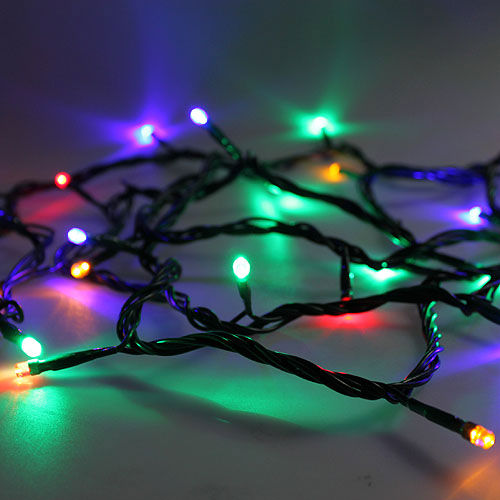
Be Conscious of Wattage When Buying Lights
Beyond just choosing between LEDs and incandescent bulbs, the holiday revelers have more decisions to make while buying holiday lights. Even among LED options, the energy use is not the same. To make an educated decision about which box of lights to buy, consumers should recognize the importance of the wattage of their lights. The greater the rated wattage on a string of light, the more energy they will consume once plugged in. And while you may be choosing between something that seems of minimal difference, such as 10-watt lights vs. 7-watt lights, over the course of the holiday season and with many lights across your home the difference can add up.
Here’s an example. Let’s say you need four strands of lights for your six-foot Christmas tree, another four strands for an outdoor tree, and another ten strands for your roof, windows, and the rest of outdoors. You may quickly lead up to 1,000 individual twinkling bulbs on your holiday light setup that are going to be lit for 6 hours per night for the full month of December. While you might have made the energy-conscious decision to use LEDs, there are LED strands that use less than 0.1 watts per bulb and others that use nearly 1 watt per bulb.

Source: Christmas Lights Etc.
That’s a difference of 0.6 kilowatthours per night and 6 kilowatthours per night, a huge energy difference! So don’t stop just at choosing LEDs, but be conscious of the wattage of your LED holiday lights.
Plug Into Smart Plugs to Limit Time Lights are On
Once you have your holiday lights purchased, the best way you can address exactly how much energy they will use is by being conscious of how often they are lit during the holiday season. It doesn’t take an energy expert to realize that the longer you leave them on, the more energy they’ll use and the more your electricity bill will reflect that! While everyone can simply be aware of when they turn the lights on and when they turn them off, smart technology has made controlling energy use from holiday lights all the easier.
Specifically, you can plug your holiday lights into smart plugs. Smart plugs are devices that you plug directly into your outlet and then you can plug your holiday lights into the smart plug. In that way, you can now use an app, web portal, or even home voice assistants like Amazon Alexa to control when power is delivered to the lights and when they are turned off.
Using these smart plugs, you can schedule exactly when the lights turn on and off each night, ensuring you never forget to turn them off, laziness never gets in the way, or any other reason. Even better, you can control the smart plug remotely to adjust this schedule via the associated app. If you unexpectedly are out of town for a week and don’t want the holiday lights to be lit while you’re gone, all it takes is the tap of an app on your smartphone to make sure they aren’t being lit while you’re out and using energy you’d rather conserve. Note that Atlantic Energy’s Smart Home Bundle offers customers three smart plugs after 18 months of service, and these smart plugs can leverage the automation capabilities of the associated Atlantic Energy App to help control the lights and minimize energy use.

Don’t Let Your Lights Be Energy Vampires
A last energy-saving tip for holiday lights relates sounds like it comes from Halloween instead: use smart technology to prevent energy vampires! An electronic device turns into an energy vampire when it continues to draw electricity from the power socket despite being off, simply because it’s still plugged in.
If you have strands of holiday lights plugged into outlets all over, both inside and outside your home, they will continue to draw trace amounts of electricity from the outlets even if you’ve switched the lights off. This is another situation where individually it may not seem like much energy, but over many different plugs and for hours each night for a month, it can really add up.
To prevent your holiday lights from becoming energy vampires that suck electricity from your wall, there are a number of strategies. First is to use a power strip to plug all your lights into at once. That way you can switch off the power strip which will prevent the power draw to each of the individual plugged-in devices. In a more direct way, you can opt to unplug your lights when they’re not in use rather than just turn them off, or more conveniently have them plugged into an outlet that’s controlled by a light switch so you can cut the power to the outlet entirely.

There’s no need to be a Scrooge and not want to use your electricity to go towards illuminating your home for the holiday; it’s a fun way to bring your family and community together. But if you want to remain conscious of conserving energy these tips can help you minimize the impact on your energy use and your power bill!
Smart plugs have long been available to fill in the gap and make any product or piece of equipment that uses electricity ‘smart.’ The smart home gadget market has been around for a while and introduces new products and appliances annually, such as the smart plug.
There was a time in the technology industry where you would only participate if you were savvy enough to understand concepts like the Internet of Things or IoT. Also, as you can imagine, it’s a pretty expensive world to tap into.
However, that has long changed. In fact, over the past few years, production has seen the smart home market explode in offerings and popularity… and a large part of that trend has been smart home product affordability, as well as products being intuitive and easy to use.
What Is a Smart Plug?
Smart plugs are small products that plug directly into the outlet in your wall. They have the same outlet openings on their side to allow you to plug products into the smart plug, as you typically would into the wall.
Within the smart plug, though, is where the magic happens. Smart plugs could be controlled remotely or automatically, connecting via WiFi to the rest of your smart home devices. This connectivity gives users the ability to turn a smart plug on and off from the Atlantic Energy App on their smartphone, or with the voice command used with Amazon’s Alexa or Google Home. Users can also set up an automated schedule ahead of time via the Atlantic Energy App.
The ability to control whether the product plugged into your smart plug is on or off remotely, without needing to be in the room or even in the house, is the crux of a smart plug’s ability. It also is affordable and can be used by anyone to improve the smart aspects of their home.
How Do You Use a Smart Plug?
Smart plug use depends on the exact model you purchase because different products have their separate instructions and functionalities. Broadly speaking, once you plug your smart plug into the wall, you’ll be able to follow the product’s directions to connect the smart plug to your Atlantic Energy App. Once connected, all you ever have to do is activate and deactivate the smart plug and whatever you’ve plugged into it will turn on and off instantly. You can plug your smart plug into a lamp, an entertainment center, a fan, or anything else with a plug load.
Smart Plug Benefits?
There are plenty of benefits when using a smart plug. May it be automation to saving energy, there are plenty of ways to create a more efficient and environmentally safe environment in your home.
You can set up the smart plug to work on an automatic timer, such as connecting holiday decoration lights, so they automatically get powered on when the sun goes down, and it will even power off when you go to bed.
The possibilities for how to use this function stretch as far as you can be creative. For those who love staying in bed, you can use the smart plug to turn the bedroom lamp on or off without even jumping off your mattress! You also don’t have to get up in the middle of the night to change the temperature, and you can turn on your slow cooker when you’re not even home.
Smart plugs don’t just allow the flexibility to make your home products smart and convenient. They also can easily open up the door for energy efficiency and eliminating wasted energy anywhere across your home. This feature ensures your smart home is also an eco-friendly green home.
How Much Energy Do Smart Plugs Use?
Increasing sustainability and going green with smart plugs are key to a healthier home. Smart plugs use about 1-2 Watts of power. Your energy bill is measured in kilowatts per hour. That’s 1,000 Watts to 1 kWh. So, 1 Watt of power can translate to 8.76 kWh of electricity over one year. That’s a lot of potential energy saved.
Common Uses for Smart Plugs?
Smart plugs create the ability to reduce energy use during times when energy going into devices in your home would be inherently wasted. For large houses or homes with children, a common source of energy waste comes from leaving the lights on when no one is home.
With lights connected to a smart plug, you can have peace of mind by checking and turning off the lights that may have been left on and were drawing power when you’re not home. Users can also automatically turn off lights during specific times when homes are always empty.
Going further, a common source of wasted energy is when large electrical setups remain plugged in and take up power even when they’re off. A typical example is a home office that has its computer, monitor, printer, fax machine, and phone all plugged in. This takes power from standby use.
Another example is a home entertainment center. These rooms have televisions, cable boxes, AV receivers, DVD players, video game consoles, etc. all plugged in and drawing standby power while not in use. If these setups were to be plugged into a smart plug, then users can automatically turn all of these devices off with the single press of a button when they are not in use, or tell the smart plug to turn them off during the expected hours they will not be needed, and thus potentially save all that wasted energy!
Are Smart Plugs Worth It?
Increasing sustainability and going green with smart plugs are key to a healthier home. Smart plugs use about 1-2 Watts of power. Your energy bill is measured in kilowatts per hour. That’s 1,000 Watts to 1 kWh. So, 1 Watt of power can translate to 8.76 kWh of electricity over one year. That’s a lot of potential energy saved.
Renewable energy is a source of power generation that does not rely upon the burning of fossil fuels, but rather the ‘fuel’ is a natural resource that is not only plentiful and freely available, but replenishable. Most people these days are familiar of renewable energy, and in the eco-conscious era in which we live they are aware of the suite of benefits an energy mix that’s higher in renewable energy brings: reduced pollution of water and air, elimination of carbon emissions that are causing climate change, and a general push towards environmentally-friendly and sustainable energy use.
However, when discussing renewable energy most people will simply think of solar energy and wind energy. After hydropower, solar and wind are the most common renewable energy sources used across the United States, so it’s not surprising these are the renewable sources with which people are most familiar. According to the United States Energy Information Administration (EIA), hydropower, solar energy, and wind power account for 15% of all U.S. electricity and 89% of all U.S. renewable electricity. While that demonstrates just how important these energy sources are, the data show that there were 73 billion kilowatthours (kWh) of renewable electricity generated in the United States in 2018 from other renewable energy sources; that’s enough energy to power over 6.5 million U.S. homes for the year. So while it’s understandable hydro, solar, and wind are the main events, the other renewable energy sources out there are contributing a whole lot. So what are these other less discussed renewables?

Geothermal
The same EIA data shows that geothermal power was used to generate 16 billion kWh of electricity in the United States in 2018, 0.4% of all U.S. electricity. As defined by the International Renewable Energy Agency (IRENA):
Geothermal energy is heat derived within the sub-surface of the earth. Water and/or steam carry the geothermal energy to the Earth’s surface. Depending on its characteristics, geothermal energy can be used for heating and cooling purposes or be harnessed to generate clean electricity.
The advantage that geothermal energy has is that the heat is already coming from the earth, all we need to do is drill down to tap into it! But the downside is that not every part of the planet is suitable for geothermal energy. Some areas don’t have the natural heat nor the ability to drill down, and because of this geothermal energy is a sustainable energy source that is terrific for those who live in appropriate areas to go green, but it’s not widely scalable as a renewable solution across the globe.
Biomass
Biomass energy is an umbrella term that covers numerous types of renewable energy generation. While the EIA data show biomass totaled 58 billion kWh of electricity generation in 2018 (good for 1.4% of total U.S. electricity), that’s broken out into wood (41 billion kWh), landfill gas (11 billion kWh), and municipal solid waste (7 billion kWh).
Generally speaking, biomass (according to EIA) is an organic material that comes from plants and animals and it contains stored in it energy from the sun. Thinking back to your high school biology classes, you’ll remember that plants absorb the sun’s energy via photosynthesis and then anything that consumes those plants or uses those plants take on that energy. The idea of biomass energy it to take these sources of biomass and burn them to create heat, either to heat an area of generate electricity.
As mentioned above, biomass can take a number of different forms. Wood energy is when trees, wood waste, or other lumber products are burned for energy. Landfill gas takes all of our organic waste-- food scraps, wood products, animal waste, etc.-- and uses bacteria to brake those organic sources of biomass down and release methane. We then capture that methane (which if we didn’t capture would be a potent greenhouse gas) and then use it as a source of renewable energy. Municipal solid waste, or waste-to-energy, is a similar source of energy but instead of breaking down the waste into gas with bacteria will burn them at special waste-to-energy plants.
Other?
Geothermal and biomass are just two of the most prevalent sources of renewable energy outside of hydro, solar, and wind today, but others continue to be developed, studied, and implemented. These sources that may become a bigger source in the future include tidal energy, hydrogen energy, wave energy, and more.
When you become a member of Atlantic Energy, one of the aspects of their service that sets them apart from other potential energy providers you could have gone with is their Smart Home Bundle. While the reliable and clean energy delivery at a competitive cost is certainly more than enough to get your attention, the smart products they offer customers over the first two years of service really go the extra mile to lift them above the competition.
For new customers of Atlantic Energy who sign up with the Smart Home Bundle, they are rewarded with various products and services at a $650 retail value over the first two years, with those products arriving at your doorstep in incremental steps along the way:
This value-added should raise some eyebrows and capture your attention, especially because those smart home products are ones you'll be able to keep no matter what. I was lucky enough to receive the 90-day package-- 1 Wi-Fi Smart Camera and 3 Wi-Fi Color Changing LEDs. Having not dabbled in smart home products too much previously, these devices gave a great sense of the possibilities behind the Internet of Things and how connected devices can make your life easier, more fun, and-- importantly-- more energy efficient.
Read on to hear about my experiences and overall review of the 90-day package.
When the devices came, they were all packaged neatly together and with their own individual boxes. Again, this first delivery included 1 Wi-Fi Smart Camera and 3 Wi-Fi Color Changing LEDs.

The nice compact boxes were nice because they minimized any extra packaging materials, and the clean look had me excited to dive in right away.
One of the most significant factors that scare people away from investing in smart home products is a fear of how complicated they will be to set up and use. Any fears like that are cast aside when seeing how brief the instructions included are:

And to be clear, these instructions aren't brief because they're lacking, rather the instructions are brief because of how much of the installation and setup process is straightforward, automated, and dummy-proof (click here for an overview on how to install the smart lights and click here for an overview of how to install the smart camera). Including the time it took to actually download the Atlantic Energy app, you're looking at less than 5 minutes of installation time per product. It's hard to beat that.
To gain full functionality, you're also well-served to connected these devices (particularly the smart lights) to Amazon Alexa or Google Home, which enables voice control. Again, follow the instructions provided (and reference the 'help' section of the app if you run into issues) and you'll be up and running in no time at all.
Once the installation is complete and you're on the app, the fun really begins. Each product and the app itself really comes with a smorgasbord of cool, useful, and energy-saving features. The best way to get to know these features and learn what will fit the lifestyle of you and others in your household is to start playing around, but an overview of some of my favorite aspects of these devices include the following:

Final Impressions
Overall, if you haven't dipped your toes into the smart home market before then Atlantic Energy's Smart Home Bundle might just be the package you've been waiting for. The ease of use, variety of available functions, and sleek look of the devices would all be reason enough to jump at the opportunity, but keep in mind these devices are included free after 90 days of becoming a customer of Atlantic Energy and their clean and affordable power.
You could be forgiven for thinking this was all too good to be true, but Atlantic Energy would love to prove it to you! Get in touch today to find out more.
Atlantic Energy strives to be more than your run-of-the-mill energy provider, looking for innovative ways to help customers improve their experience and reward them for their choice to remain with Atlantic Energy. Beyond our ability to provide you with clean and reliable energy at an affordable price, one of the key ways we set ourselves apart is with our Smart Home Bundle. As a residential customer, you will be set to receive 1 Wi-Fi Smart Camera after 90 days as a customer, with a second one being delivered after 6 months of being a customer, along with all the other smart home products awarded over the course of the first 24 months as a customer that total a $650 retail value.
Delivering these smart cameras is just the first step, though, as Atlantic Energy seeks to ensure you are able to set them up and use them properly to get the full benefits from them. As a part of that process, keep reading to follow along with the unboxing, setup, and use of one of the Wi-Fi Smart Cameras for use in an actual apartment.
The Wi-Fi Enabled Smart Camera delivered by Atlantic Energy is a powerful but still intuitive piece of equipment. Features of this smart camera include the ability to flip video so you can position the camera in any orientation, motion detection so choose to only record when there’s movement (saving energy) and allowing the receipt of notifications to your smartphone when motion is detected, a MicroSD card slot that enables recording and playback and night vision.
To start, though, the camera you’ll receive will be in a simple box that looks like the following:

Open it up, and you’ll see the sleek camera in safe and tight packaging:
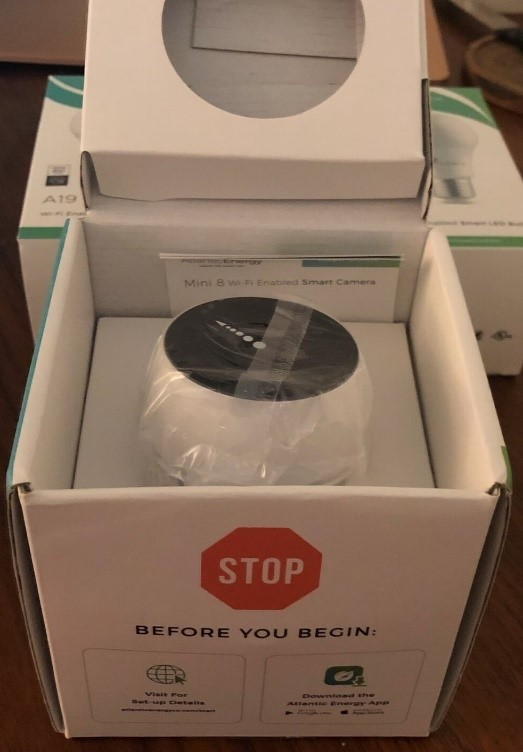
Take the contents out of the box, and you’ll see the compact Wi-Fi Smart Camera, the adapter needed to plug it in, and a small instructions booklet:
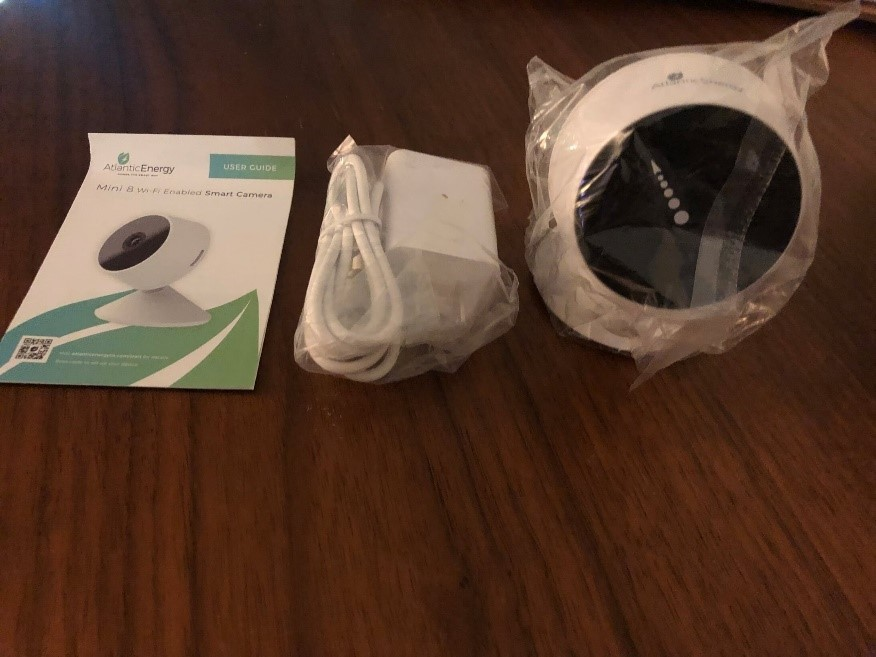
The setup process is straightforward and easy enough that the instructions are able to be brief, to the point, and simple:
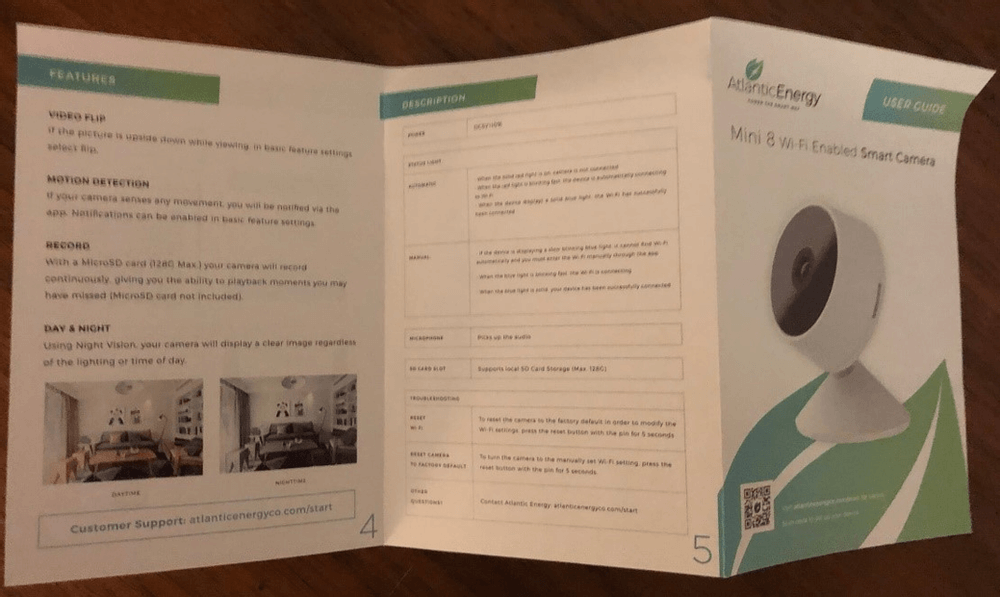
Before grabbing your phone, the first step is to plug the adapter into the camera:

Followed by plugging the adapter into the wall, at which point you’ll see a light on the camera turn on and a red light blinking to indicate it’s ready to pair:

Now that the camera is unboxed and plugged in, the real fun part can start! The innovative part of the camera and what will make it particularly useful for you is that you can access and control it via your phone, so you’ll next need to download the Atlantic Energy app on your preferred app store on your smartphone:

After the download is complete, open the app up and follow to on-screen instructions to register:

At that point, you’ll see the following empty screen. To add your Wi-Fi Smart Camera to the app, start by pressing the + in the upper right corner:

From there, you’ll note that you want to add a ‘Security Camera.’ You’ll then be asked to confirm that the indicator light is still flashing:

After confirming that this is the case (and if not, select ‘otherwise’ on the app and it will indicate what you should do to reset the camera to get the indicator light flashing again), you’ll be prompted to enter your Wi-Fi password. Next, your phone will pull up a QR code as shown in the following. Point the QR code at your camera as instructed, and tap the button on the app after you hear your camera let out a beep:

You’ll now have to wait for a minute or two for the process of pairing your camera to your phone complete. Don’t hit cancel or navigate away during this time:

Once this is done, you’ll be ready to go! The app will automatically take you to a screen where you’ll be able to see what your camera sees:

If you’ve gotten to this step, you’re pretty much there! You can open up the app at any point, even if you’re not at home, to see what’s being viewed through the lens of the camera. If you want to access some of the more ‘advanced’ features, they’re on display right there for you. The ‘alarm’ button allows you to set an alert to your phone when motion is detected, the ‘speak’ button opens up the two-way speakers so you can speak through the camera (to pets or people in the home), the ‘record’ button allows you to save the video you’re looking at currently for view later, and the ‘take a photo’ button will screenshot your current view:

To get even more advanced, press on the … in the upper right corner to open up settings. Here you’ll see the ability to share your device view with others, update functions, adjust memory card settings (assuming you’ve installed a memory card, since that’s not included), and importantly set the Motion detection settings:

Within motion detection settings, you can turn on or off the motion detector (which alerts you and starts recording the moment motion is detected) and set how sensitive you want the motion detector to be (will a breeze set it off or do you want a large movement to be needed?):

After motion detection is turned on, you can opt to start receiving push notifications like the following when movement is detecting, allowing for peace of mind and added security:

At this point, you’re set up and ready to go! Atlantic Energy seeks to enable customers to remain state of the art with their home security and energy management. If you’re simply reading this but haven’t yet signed up for the Smart Home Bundle from Atlantic Energy, what are you waiting for? Reach out to us today to see how we can start saving you money on your power bill, ensure your electricity is fueled with cleaner energy, and empower you to embrace smart home technology.
Residents of over a dozen states across the country, amounting to over half the U.S. population, are lucky enough to live in deregulated energy states, otherwise known as states with energy choice. Whereas the utility sector had traditionally been a monopoly with everyone simply receiving their power from the local utility, the past two decades have seen a rise in states opening up their markets to allow residents a choice in their energy supplier.
Whether customers want to take advantage of more affordable electricity rates, support suppliers who utilize a greater proportion of clean energy sources, take advantage of unique offerings and rewards offered by certain suppliers, or any other reasoning, these people have the ability to choose their energy supplier. But how exactly does that work? Does it require new wiring or installations? And how will your bill change if you do change? These are the questions that pop to mind when residents realize they have the ability to choose energy suppliers. But to answer the overall question of ‘How does it work?’, the answer is simple: really easily.
Let’s dive in to show you.
Why would you change energy supplier?
Before getting into the ‘how’ of it all, it’s important to recognize the ‘why.’ The reason certain markets open up to allow energy choice for its customers is to tap into the natural benefits of competition. Monopolies are typically frowned upon in free markets because the motivation to improve is gone, as customers can’t switch when they’re unhappy with service or they find something better. So why was that always the status quo for the utility industry?
Deregulated energy markets get to the heart of that and put the pressure on the incumbent energy suppliers. If their prices aren’t fair, customers can now jump ship. If their energy mix uses too much dirty fuel and that weighs on the conscience of the customer, they can find a power provider that aligns more with their principles. There are many other reasons a customer may choose to change provider, just like with every other product market they deal with daily. And the beauty is: it doesn’t matter what reason they use. If a customer is unhappy with their service for whatever reason, they can find a provider that will satisfy them.
How do you choose a different power provider?
So for those who have made the choice to change energy suppliers, the question then comes to how exactly to do that. If you’re in one of the markets that does allow for energy choice (refer to this article to find out if that applies to you), the next great piece of news is this: switching is incredibly easy. You can do research online to see what power providers are available to you, even ask your friends and neighbors who they use, or you may even receive advertisements from the potential energy suppliers. But if and when you find a power provider you would like to switch to, all you need to do is contact that energy supplier. They will take care of the rest and send you any paperwork you need to sign. From there, they take care of the rest!
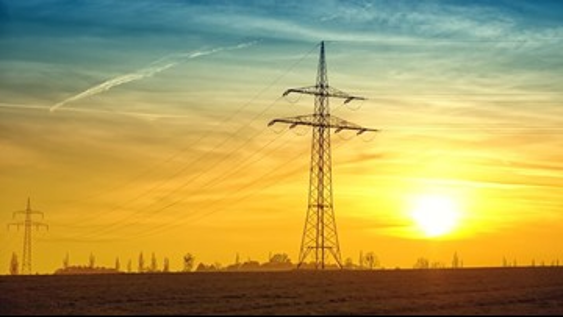
Do you need new wiring in your home? Changed equipment?
For people who don’t work in the utility industry, this is a reasonable equipment. If a different company is to provide you with your energy, how will it get to your house? Well keep the good news coming, because the answer is no: absolutely nothing needs to be wired into your home and no new equipment at all is required. How can this be? Well when you choose a new energy supplier, all you’re choosing is the organization who will generate electricity for your home. That generated power will be transmitted over the same set of transmission and distribution wires and into your home. The local incumbent utility who had always operated this grid system for you all the way into your home will remain unchanged (whether that’s the original incumbent energy provider or a separate company), and your new energy supplier will simply connect to that grid and count the energy you use as coming from their generation. So you get the benefits of this new energy supplier, but the wires delivering energy to your home remain exactly the same.
Will you have to pay multiple utility bills now?
Having a new company account for your power generation might make it sound like you should expect to receive multiple utility bills now, one from the incumbent who operates the transmission and distribution system and another from the generator you chose. However, another piece of lucky news for you: you’ll still only receive a single power bill. This bill will even look just like the one you’ve always gotten; the only difference is in the line item for energy generation it will list your new chosen supplier. You still pay one single payment per month like you always have, and the utility companies handle amongst themselves getting your money to the right entity for each service. It really couldn’t be easier!
What’s Next?
It all really is that easy. So if you’re lucky enough to live in a deregulated market, start doing your research on your options. Maybe you find a new energy supplier who speaks to you, and you can get in touch with them today to find out more. Maybe you’ll even find one who will offer you a package of free goodies just for being a customer, like Atlantic Energy’s smart home bundle!
There once was a time where electric vehicles on the road were just an impractical plaything for the wealthy who got early access to a Tesla. But actually, if you go back further, electricity was actually one of the options to run early developed automobiles before gasoline won out as the preferred technology. Despite having to wait well over a century to grab mainstream attention and acceptance, we’re finally at a time where seeing electric vehicles (EVs) in your neighborhood and chargers at your local store are rather commonplace.
You may find yourself wondering whether or not you’re ready to take the plunge into the world of EVs, as the 16% of Americans who say they are likely to buy an EV next time they go car shopping, and if so here are the questions you need to ask yourself:
How often am I driving long distances?
Range anxiety is one of the biggest deterrents to buying EVs. Customers may want to go green and drive more sustainably, but not knowing if you’ll be able to recharge when and where you need is a scary thought. So to see if an electric vehicle is compatible with your way of life, consider how often you’re driving long distances. EVs have a battery range that can go as low as less than 100 miles to greater than 300 miles, but even the high-end models with 300+ miles of range won’t necessarily be sufficient if you’re planning long road trips with any type of frequency. If you drive cross-state for holidays, like the option to pop into a car and drive hundreds of miles at a moment’s notice, or anything else, then you need to consider how purchasing an EV will impact that. If the EV is not your only vehicle and you can use the gasoline-powered car during longer trips (or even are willing to rent one), then it may not be an issue. But if you plan to only have an EV and you’re frequently driving a few hundred miles here and there then the need to stop and charge for 30-60 minutes in the middle of those trips may not be what you are willing to deal with.
Do my frequent destinations have chargers?
For shorter, more frequent trips, a great question to examine is whether your frequent destinations already have built-in publicly available chargers. For example, if you drive to work, does your parking lot or parking garage have an EV spot you can use? Similarly, do you have a frequent shopping center or restaurant you’d be driving to that has such chargers available? Having the ability to charge at these frequent destinations can minimize your day-to-day range anxiety and also maybe save you money if they are free to use. If you live in an area where chargers are already built out well, such as California, Hawaii, or Maryland, then integrating charging into your activities as you run around doing errands is not as big of a deal.

Is my garage outfitted with the right equipment for a home charger?
More often than not, though, your EV charging will take place at home. But not all EV charging is done the same. If you were to just plug into your basic outlet at home, an EV would take over 20 hours to completely recharge an empty battery. This would be using Level 1 Charging, but given that speed is sufficient for frequent drivers who will want their car to be fully charged in the morning when they’re ready to leave again, then that might not be enough. For those who need faster charging at home, they can consider installing a Level 2 Charger that can do the trick in just a handful of hours. The problem, though, is that installing a Level 2 Charger requires a 240V outlet, a separately purchased piece of equipment that will cost a few hundred dollars, and a professional to install it. The 240V outlet is the biggest issue, though, as not all garages or areas where you may envision parking your EV will have the wiring completed in such a way, particularly in older homes. So if you need that faster charging and you need to install a 240V outlet, that needs to factor into your consideration.
Can I afford it?
Lastly, a huge factor stopping many people from making the green and eco-friendly decision they want to with an electric vehicle purchase is the cost. While the prices have dropped dramatically since the early days of Tesla and made EVs more accessible to regular families, they are still certainly more expensive than their gasoline-powered counterparts when looking at sticker price. The important factor to consider, though, is lifetime price and costs. According to the U.S. Department of Energy, it costs about half as much to drive an electric vehicle per mile thanks to the fact that electricity is cheaper than gasoline. Similarly, the costs for routine maintenance and repairs over the life of the EV is 25% lower than that of the gas-powered equivalent, making the lifetime costs again more accessible. So don’t just look at the sticker price and decide you can’t afford to make the energy-efficient and sustainable decision-- if you can front the costs to go electric, it very well may pay for itself in the end!
The energy industry is a rather unique one in the United States, as customers have for the longest time not been given a choice in whose services to use. From the beginning of the utility industry, back in the days of Edison and Pearl Street Central Power Station, a single company would own and operate the energy generation and transmission equipment and customers would only be given the choice: receive power from this company or don’t receive power at all.
Given how quickly constant and reliable electricity became essential for a healthy, safe, and productive daily life, the result was monopolies and a lack of competition among energy providers. In capitalistic societies, competition is cited as the driver of innovation, customer benefits, and progress, so it became no wonder why later into the 20th century the utility industry was largely known to be filled with inertia and was consistently slow to change.
In the past few decades, though, American customers have slowly and progressively been given the option to switch energy suppliers as regulations and politics have changed to allow for competitive energy suppliers. However, those with the ability to switch energy suppliers are still in the minority across the United States, while those without such an option continue to fight for their right to energy choice.
In the meantime, though who is eligible? There are a number of criteria to consider:
What State Do You Live In?
The first indicator of note to find out whether you might be eligible to switch energy suppliers is based on the state in which you live. As noted in the below graphic by ElectricChoice.com, there are 17 states (and Washington DC) where switching energy supplies is an option:

For those in the blue states (Connecticut, Delaware, Illinois, Maine, Maryland, Massachusetts, Michigan, New Hampshire, New Jersey, New York, Ohio, Oregon, Pennsylvania, Rhode Island, Texas, Virginia, Washington DC), they may be eligible given the rest of the factors. But for states in white (the majority of the country), energy choice is not available at all.
What Type of Energy Do You Use?
As the above map’s legend indicates, the next determinant is based on whether you’re talking about switching gas supplier or switching electricity supplier, since they are covered by separate regulations. Some states allow a degree of choice in gas markets, some in electricity markets, and some in both. So if you are in a state that only has deregulated gas (such as Colorado) but the only energy you use in your building is electricity, then you are not eligible to switch suppliers.
What Type of Customer Are You?
Beyond that, states that do have a level of deregulation are not completely deregulated and there are case by case bases to consider. For example, New Hampshire’s natural gas choice is not offered to residential customers but only commercial/industrial customers. Conversely, California’s electricity choices is available to residential customers but it’s strictly limited by capping how many people can participate at a time. This delineation of which types of customers are eligible is broken down well by the Energy Choice Coalition.
How Much Energy Do You Consume and Other Factors?
Beyond just the type of customer, there are also some restrictions based on the size of the customer. The availability of switching gas suppliers in Texas is only present for commercial customers who exceed 3,650 million cubic feet of gas consumption per year, meaning only the largest consumers. In Virginia, as another factor, customers can only switch electric suppliers if they are seeking to go to 100% renewable energy and their current legacy utility does not have such an option.
How Do You Really Find Out?
These are just some of the confusion and sometimes complex factors that will determine whether or not you are eligible to switch energy providers. Across the United States, it’s truly a patchwork of policies and regulations, making it hard for even an industry veteran to keep track of it all. As such, the best option is to contact your local resources and do your homework. For customers in New York, New Jersey, Pennsylvania, Ohio, Illinois, Maryland, Connecticut, Massachusetts, and Washington D.C. you may be eligible to choose Atlantic Energy as your energy supplier, but best to call Atlantic and talk through your options with us.
The winter season can mean plenty of things to different people: treasured time with families during the holidays, hot chocolate and snowball fights, or even a reason to bust out your favorite sweaters and jackets. But for those of us who constantly think about how to sustainably live green and reduce energy use for our monthly bills, winter means the return of high power use to stay warm.
It doesn’t have to be that way, though, as this winter you can integrate these 5 top energy saving tips that will let you stay warm and integrate eco-minded energy savings at the same time:
1. Reverse the direction of your ceiling fan’s rotation
We’re starting off with one that most people may have never thought of, but you can actually use your ceiling fans to keep rooms in your home warm. When you look at the blades of a ceiling fan, you’ll notice they are tilted in a specific direction, and when you turn this fan on during the heat of summer these tilted blades serve to circulate air and cool you off and push the warmer air (which, physics tells us, naturally rises). But for the winter months, you can reverse the direction of your ceiling fan so it spins clockwise (as opposed to the standard counterclockwise) and that tilt helps to drive the warm air downwards. This strategy will help warm your rooms in a much more energy-efficient manner than ramping up the thermostat would, saving you up to 10% on your heating costs each winter.
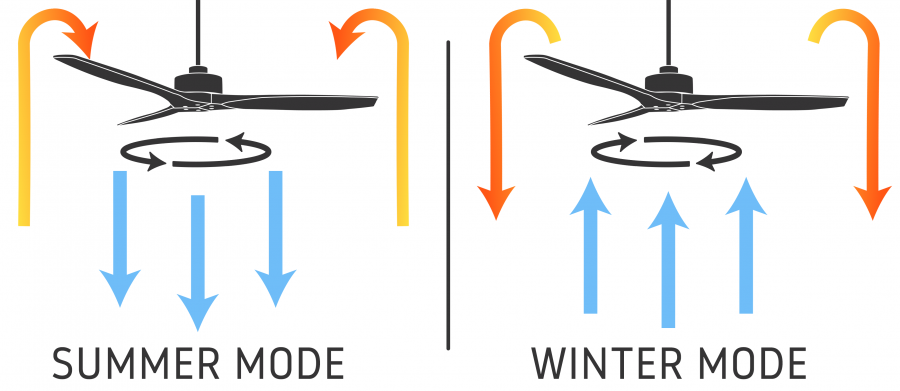
2. Utilize the capabilities of smart thermostats to minimize wasted energy in heating
And speaking of thermostats, the Internet of Things (IoT) has really taken hold of the thermostat market and can help you to target and optimize how you heat your home so it maximizes results while minimizing wasted energy. As Atlantic Energy has noted before, smart thermostats can save your heating energy use in numerous ways.
To start, smart thermostats allow you to ensure a warm home whenever you’re home without ever having to waste energy to heat your home while you’re away. Whether through the smart learning feature where a smart thermostat learns your schedule, by setting a strict schedule of when to heat and when not to, or even by tapping into geofencing capabilities that will know to start heating a home as you approach the front door, you can save immense amounts of energy (up to 10-12%) by purposely heating only when is necessary rather than 24/7.
The other capability opened up by installing a smart thermostat is in easily and smartly adjusting the level your thermostat is set to on the fly. The U.S. Department of Energy notes that you can save as much as 10% of your energy use in heating by adjusting your thermostat seven to ten degrees if you’re able. So because your smart thermostat is connected to your phone, or maybe even your home voice assistant, you can take advantage by manually adjusting your thermostat down to minimize the energy you demand from it.
3. Dress and use your curtains in an energy-conscious manner
Windows are typically an area of the home most vulnerable to heat loss but they can also be the easiest place for the sun to work its magic and heat up a room. Knowing how and when to take advantage of these natural pathways to the elements outdoors can do wonders in minimizing the work that your HVAC system has to do.
When it comes to the sun, during the daytime hours you want to be sure to keep the curtains open on south-facing windows. These are the windows where the sunlight will be more directly striking your home, and as the sun is the most powerful source of energy we have available to us you don’t want to allow these valuable rays to go to waste! Draw the curtains on these windows and let the sun naturally heat up your home.
Outside of these sun-kissed windows, though, you definitely want to utilize your curtains-- thick and thermal curtains specifically, if you can get them-- to keep the heat inside your home. For windows that don’t have direct sunlight, and for all windows after the sun has set, keeping the curtains closed will help insulate the windows and prevent the heat you’ve pumped into your home through the heater from escaping through the window. So it’s important to know which windows are facing which direction and properly open and close those curtains to maximize natural heating and minimizing heat loss.
4. Be sure to properly maintain your heater
Lastly, be sure not to take for granted the work that your heater is doing for you each day and night during the winter and let the equipment do its job as best as its able. The way to ensure this happens is by doing your part to properly maintain it.
To start, HVAC filters must be checked regularly (Home Depot recommends that fiberglass filters get changed every 30 days while pleated air filters get replaced every 3 to 6 months). By making sure your filters are clean, your heater won’t have to work as hard to pump out the hot air that keeps you and your family toasty during those winter nights. According to the U.S. Department of Energy, this simple act of maintenance can save you 5% to 15% on your HVAC energy consumption each year!
Another example is to make sure to not block your air vents. These vents throughout your home are where the warm air is being sent by your heater, but if you have them partially or completely covered by furniture, appliances, or other objects you are reducing the efficiency of your heating system. These blockages will heat up and your heater will have to pump out more heat until the desired temperature on the thermostat is reached. So, let your heater do its job and don’t make it harder on the equipment or on your utility bill.

5. Tap into an Expert’s Knowledge Via Home Energy Audit
If you want to be thorough and capture all ways to potentially save energy this winter, you can hire an expert to come through your home and perform a home energy audit. When you bring in the experienced energy professional to your home, chances are they’ll tell you about all the above tips but they’ll also do a thorough job to identify any other energy upgrades that can save you on your winter heating bills that are uniquely suited to your house.
In these home energy audits, your hired professional can perform leakage tests to see where heat is escaping your home (such as gaps in the doors or through inefficient windows) and offer ways to patch them. Similarly, they can highlight where insulation could help drastically decrease your home heating needs, such as in the walls or in your home’s attic.
When all else fails, calling in the big guns in a certified energy professional might be the smartest move you can make to save energy this winter.